
The eco-conscious winery is known for its playful, unpretentious spirit and a lineup of accessible and balanced wines, from crisp Sauvignon Blanc to elegant Cabs.
The post Frog’s Leap Winery Pours Sophisticated Wines in a Down-Home Rutherford Setting appeared first on Sonoma Magazine.
]]>
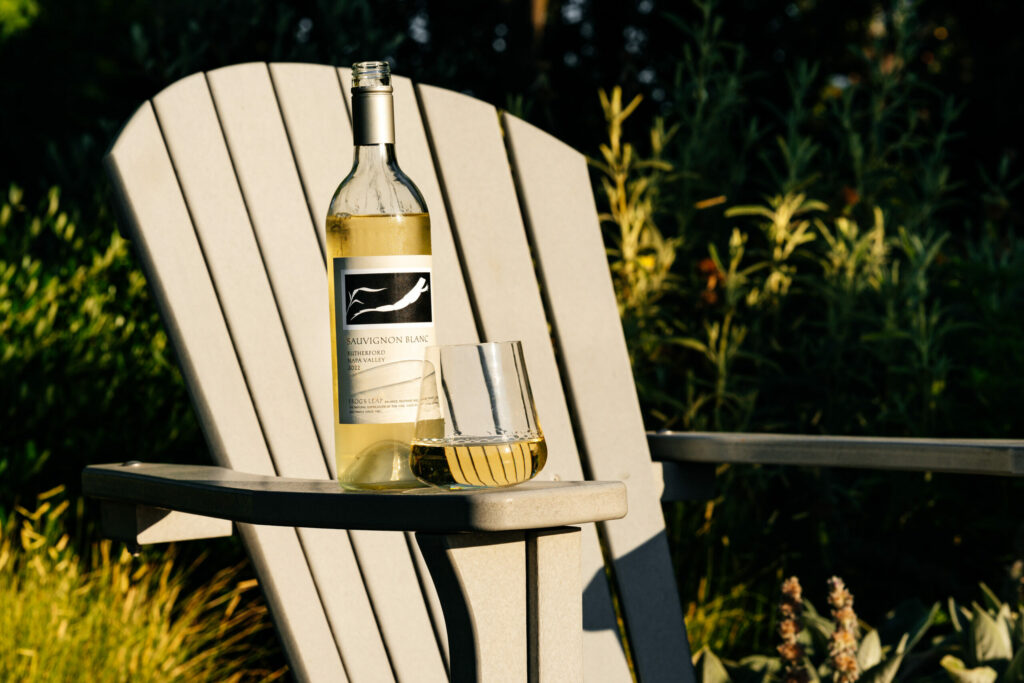
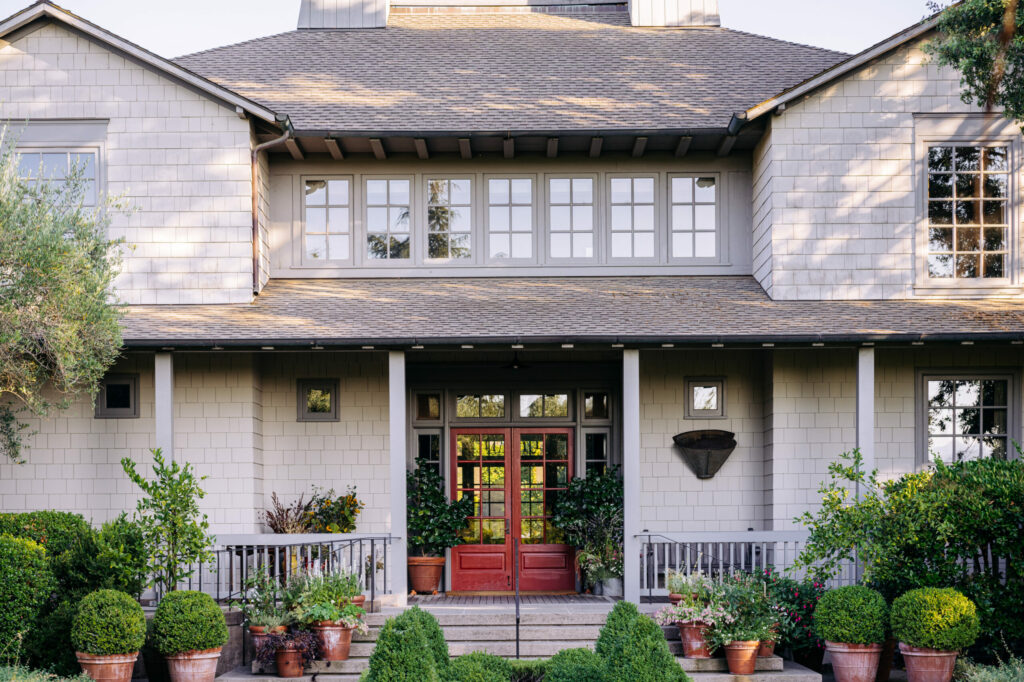
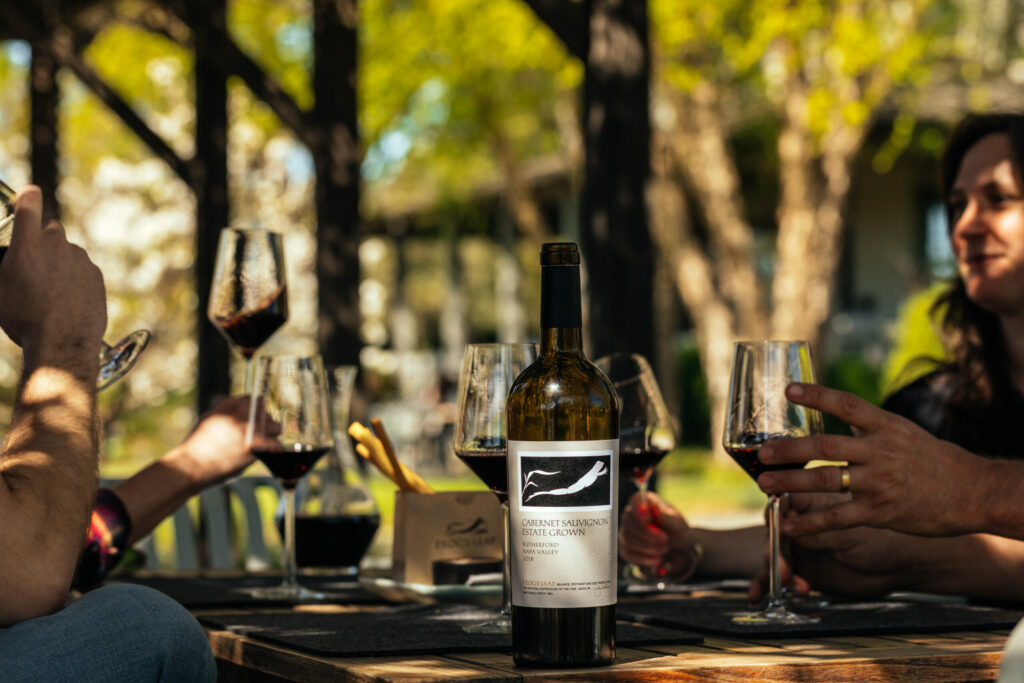
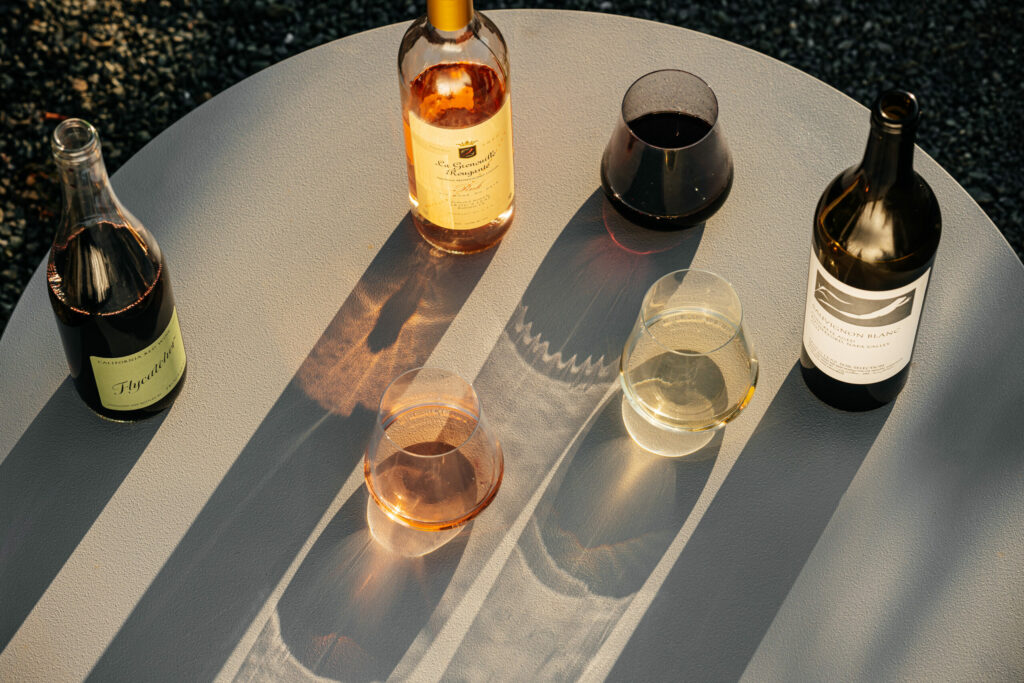
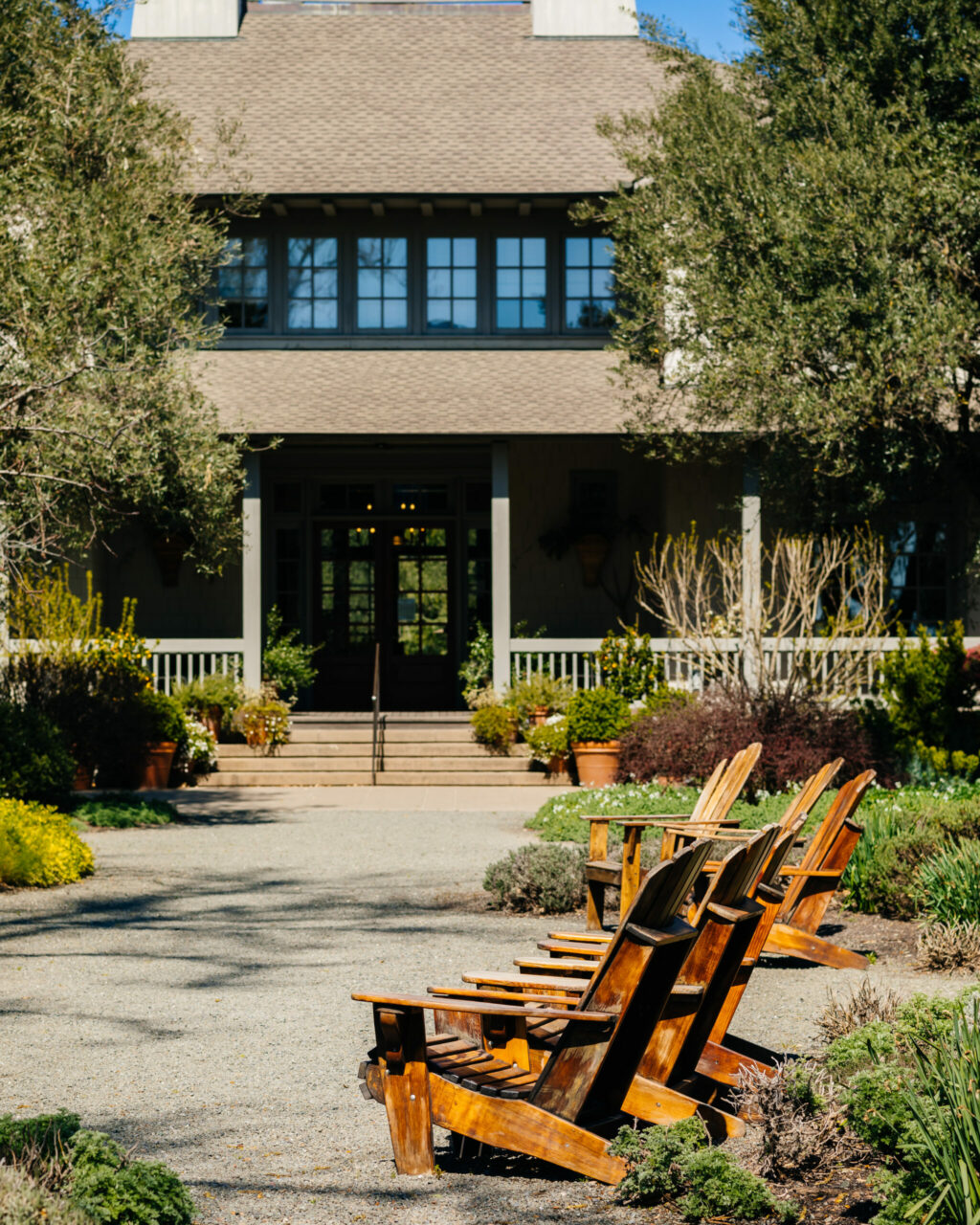
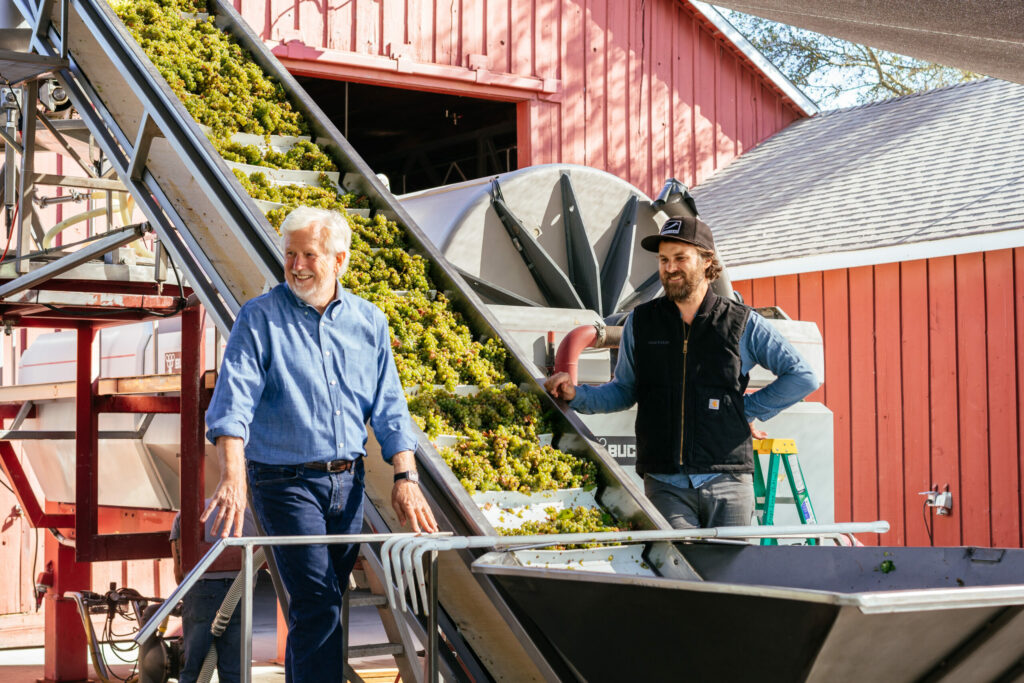

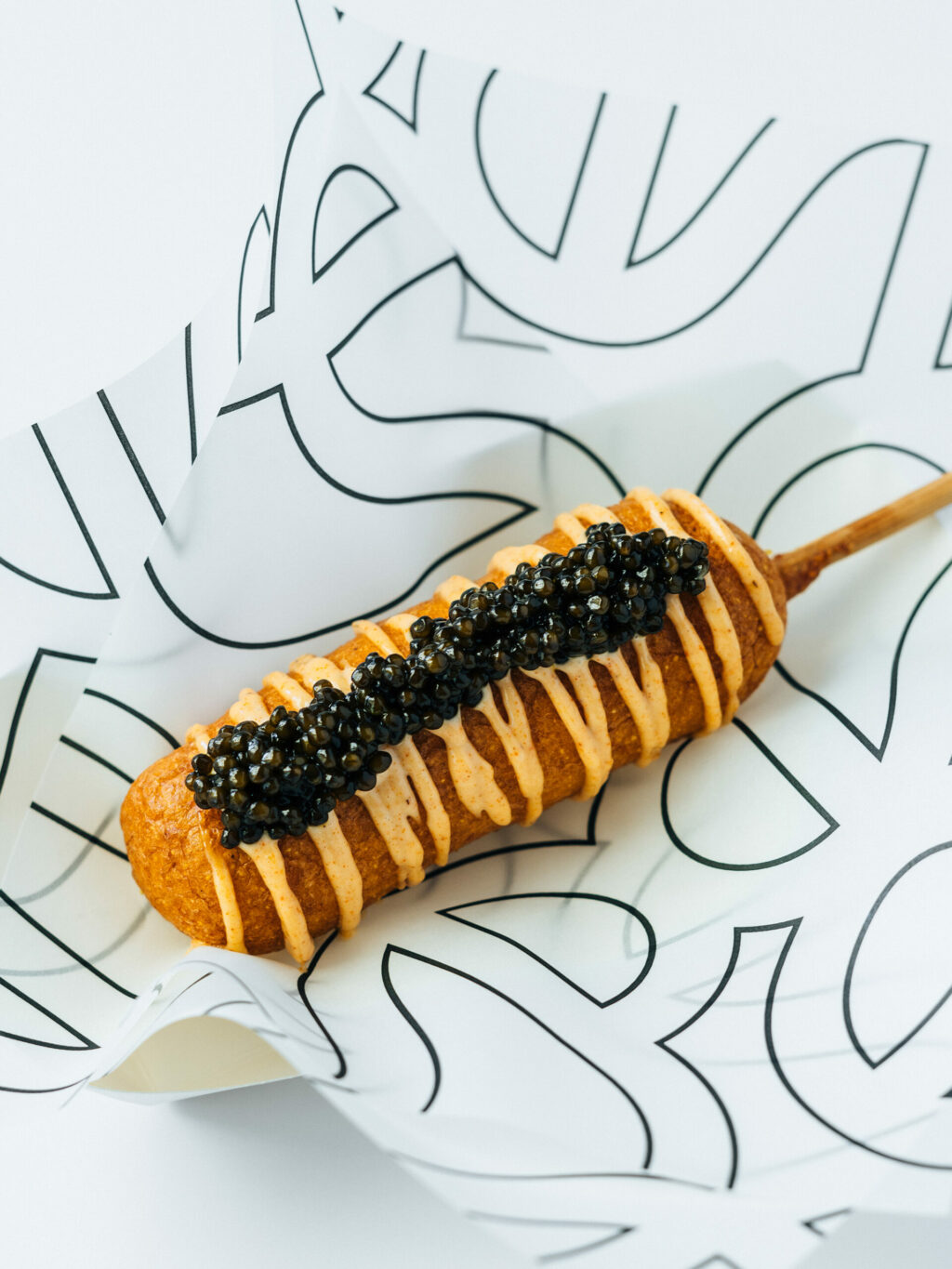
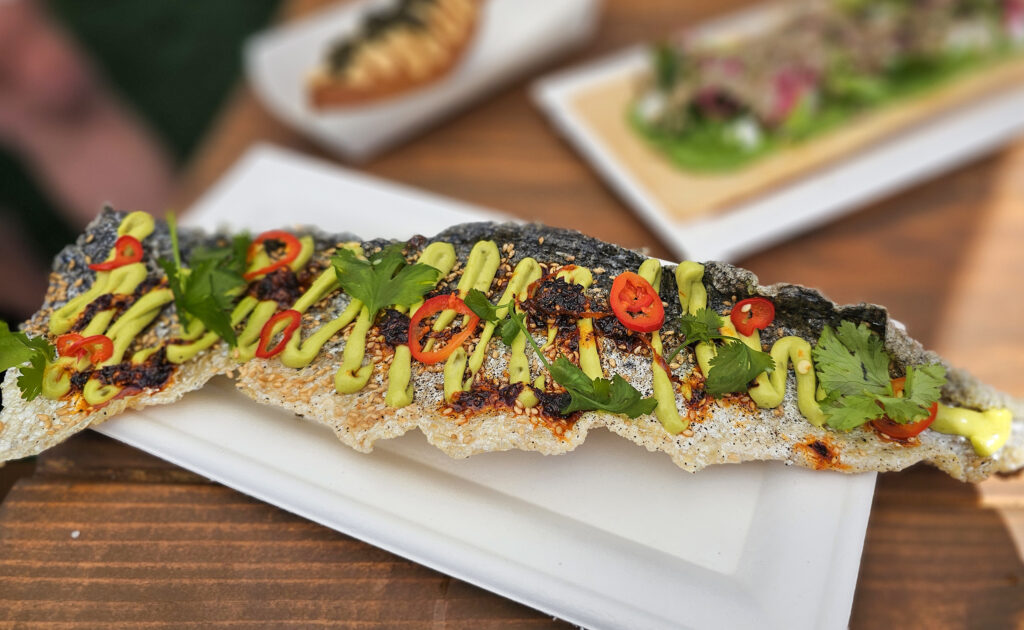
For four decades, Frog’s Leap has been making some of Napa Valley’s most expressive wines — but they’re not inclined to brag about it. The eco-conscious winery is known for its playful, unpretentious spirit and a lineup of accessible and balanced wines, from crisp Sauvignon Blanc to elegant Cabs.
The story
John Williams studied dairy sciences at Cornell University before a work-study program at nearby Taylor Wine Company inspired him to trade milk for wine. In 1975, Williams hopped a Greyhound bus for Napa Valley and pitched a tent on a rundown farm owned by Larry Turley — his college friend’s brother. Turley introduced him to Stag’s Leap Wine Cellars founder Warren Winiarski, who hired Williams as the fledgling winery’s first employee.
Williams went on to become head winemaker at Spring Mountain Winery, and in 1978, he teamed up with his original campsite “landlord” to plant Sauvignon Blanc on Turley’s property. In 1982, Williams and Turley released their first Frog’s Leap wine.

The partners went their separate ways in 1994, and Williams found a new home for Frog’s Leap in Rutherford. In the years to follow, he expanded the winery’s vineyard holdings, added fruit trees and other crops to the ranch, and became a passionate practitioner of dry farming. Frog’s Leap earned organic certification in 2002 and went solar two years later.
The Williams family now farms 200 acres of vines in Napa Valley, including 40 on the winery ranch. Frog’s Leap’s original Sauvignon Blanc is still a flagship, along with Cabernet Sauvignon.
The vibe
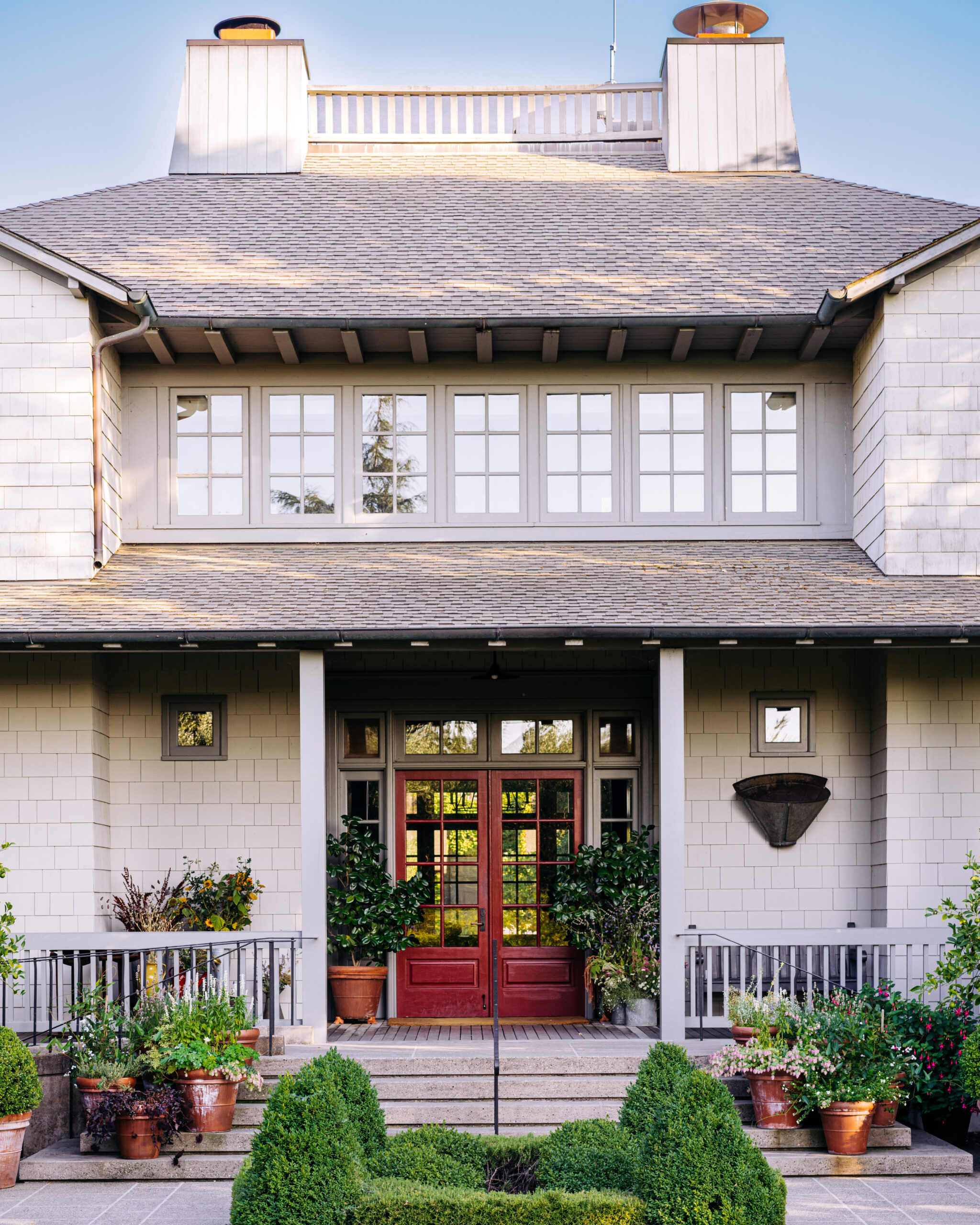
Driving onto the Frog’s Leap estate, past the restored Red Barn fermentation room, you get an instant feeling that you’re down on the farm. Because you are. The contemporary-meets-Mission-style Vineyard House tasting room — one of California’s first LEED-certified winery buildings — is surrounded by vineyards and a lush garden towering with sunflowers and bursting with vegetables.
The best place to taste is on the covered, wraparound porch, cooled in the summer by ceiling fans and warmed in winter with overhead heaters. There’s also a sweet Garden Bar set in a shady spot away from the main house, designed for casual tastings (kids and dogs welcome).
On the palate
Frog’s Leap wines never cease to impress me because they’re always balanced, elegant and just plain delicious. Head winemaker Rory Williams, John’s son, has clearly learned a lot from his dad. The mouthwatering 2023 Concrete Aged Sauvignon Blanc from Rutherford ($55) was fermented and aged entirely in egg-shaped concrete vessels, and it has the minerality and creamy texture to prove it. John’s love for Chablis reveals itself in the 2022 Shale & Stone Chardonnay ($42), aged just four days in French oak before moving to stainless steel tanks.

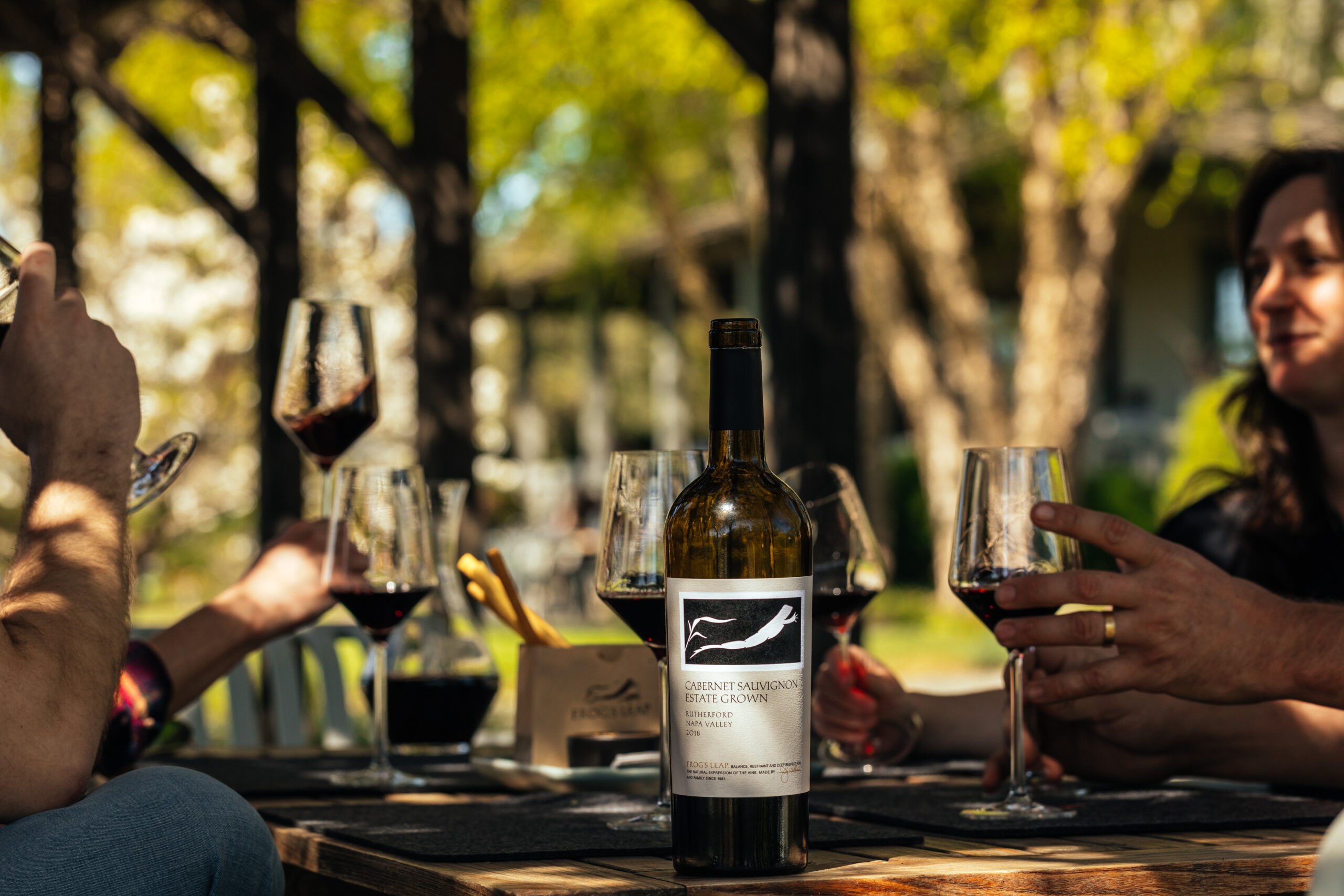
Frog’s Leap Cabernets are perpetually lovely, yet I had a hard time putting down the 2022 Napa Valley Zinfandel ($45), a sophisticated rendition that leaves those big ol’ jammy Zins in the dust. If you’re in the mood for a light, chillable red, try the multi-appellation 2023 Flycatcher blend ($35).
Tasting options include casual flights at the Garden Bar ($45) and seated tastings at the Vineyard House, ranging from $60 to $100. When you’re finished sipping, meander through the gardens to see what’s buzzing.
Beyond the bottle

For breakfast, lunch or a between-wineries snack, check out Under-Study in St. Helena, from the team at Michelin-starred Press. The casual bakery and counter-service café offers playful-yet-sophisticated bites, like the Lobster Corn Dog — a BottleRock favorite. Also find gorgeous pastries, tapas, local and international wines, and a takeaway butcher and seafood counter. Outdoor seating will open later this summer. In the meantime, patrons can order at the counter and settle in on the pretty patio at Press.
Frog’s Leap Winery, 8815 Conn Creek Road, Rutherford, 707-963-4704, frogsleap.com
Tina Caputo is a wine, food, and travel journalist who contributes to Sonoma magazine, SevenFifty Daily, Visit California, Northern California Public Media, KQED, and more. Follow her on Bluesky at @winebroad.bsky.social, view her website at tinacaputo.com, and email her story ideas at tina@caputocontent.com.
The post Frog’s Leap Winery Pours Sophisticated Wines in a Down-Home Rutherford Setting appeared first on Sonoma Magazine.
]]>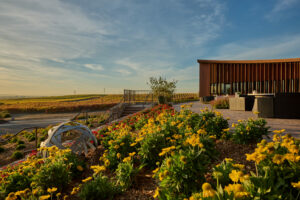
The Pinot Noir specialist offers an array of fun experiences, from terrace tastings to falconry demonstrations.
The post Bouchaine Vineyards Pays Homage to Burgundy in Wind-Swept Carneros appeared first on Sonoma Magazine.
]]>









For a winery that only makes about 16,000 cases each year, Bouchaine Vineyards has a lot going on. The Carneros winery makes an array of delicious, single-vineyard and single-clone Pinot Noirs, plus Chardonnay, aromatic white wines and more. With 20 different small-lot wines on the roster, this is definitely a something-for-every-palate situation. You’ll also find plenty to do at the winery, from lounging on the tasting room terrace to soaring with falcons.
The story
In the late 1800s, a pioneer named Boon Fly led a wagon train from his native Missouri to Carneros and planted the first grapes on the future Bouchaine Vineyards estate. By the time Gerret and Tatiana Copeland bought the property nearly 100 years later, the dilapidated winery buildings had seen better days. Used for two decades as a storage facility for Beringer Vineyards, the winery looked more like a slaughterhouse than a production facility for fine wines.
The Delaware-based couple had no experience planting vines or running a winery, but they did have a lifelong love of wine and plenty of resources. Gerret, a member of the du Pont family, had a successful career in finance while Tatiana focused on international business. Though Tatiana was born in Germany and grew up in Argentina, her Russian family heritage provided a pivotal connection to renowned Napa Valley winemaker André Tchelistcheff. He declared the site ideal for Pinot Noir, which was thrilling news to Gerret, who’d long dreamed of owning a Burgundy-style domaine.
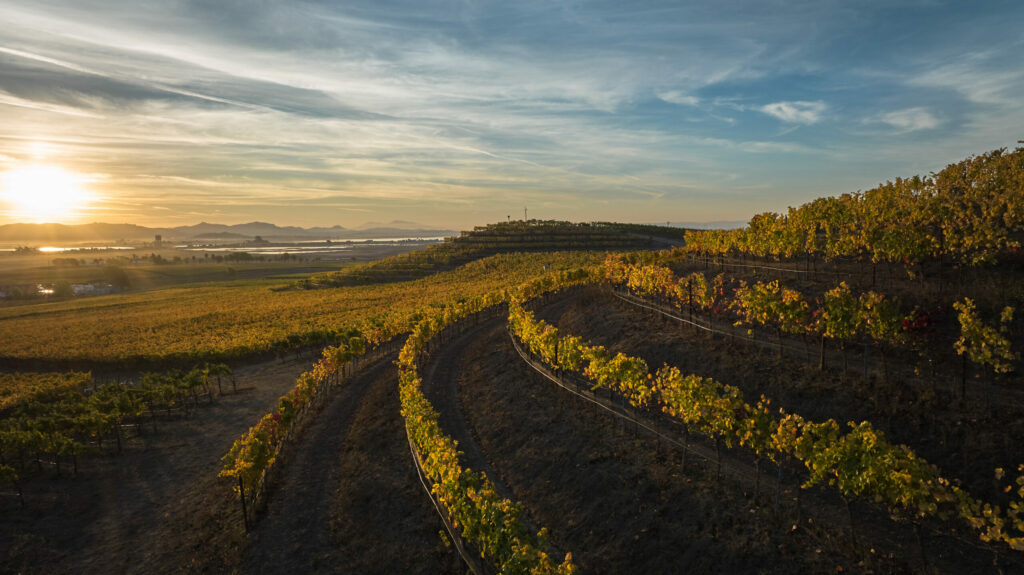
In the decades to follow, the Copelands expanded Bouchaine — the name is a play on bouchon, the French word for cork — to 100 acres and renovated the old winery buildings. Among the estate’s 87 acres of sustainably farmed vineyards are 46 acres of Pinot Noir, plus Chardonnay, Pinot Meunier, Pinot Grigio, Riesling and Syrah.
The vibe
Just outside Bouchaine’s hilltop hospitality center is a message embedded in stone pavers that sets the tone for your visit: Wine Makes You Happy. Inside the glass-walled building, renovated in 2019 to include a 2,000-square-foot terrace, you’ll find an expansive, sunlit space with a u-shaped tasting bar. Sofas and armchairs encourage guests to relax on the terrace and drink in views of the winery, vineyards and the San Pablo Bay. A second outdoor tasting area, set below the terrace in the winery’s flower garden, is a casual, family-friendly spot for bring-your-own picnics.
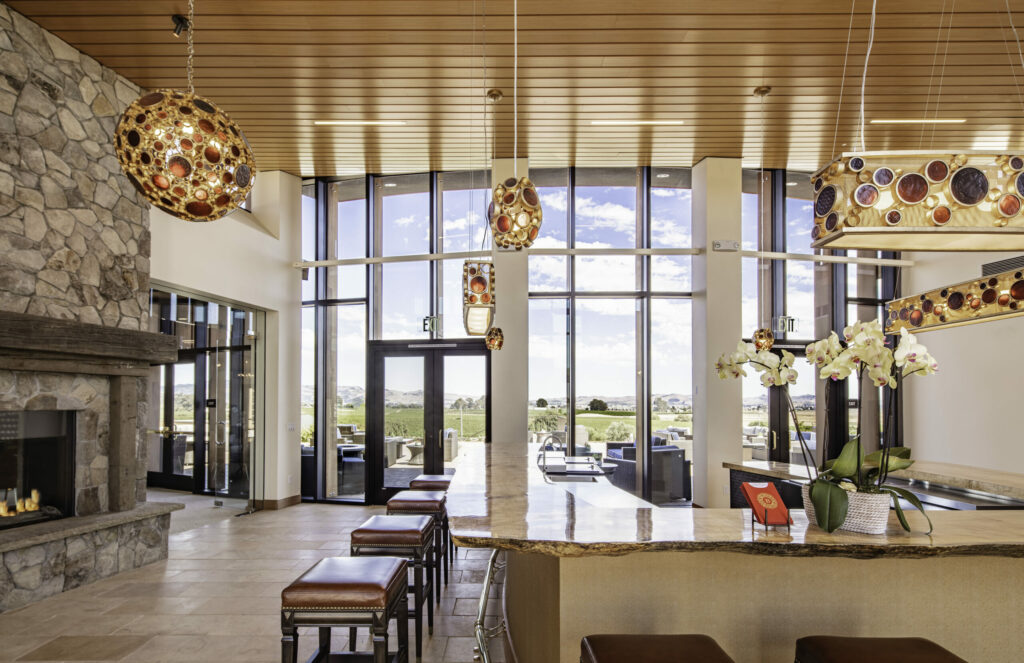
On the palate
Winemaker Chris Kajani spent years making wine at Saintsbury before joining Bouchaine in 2015, so she knows her way around Pinot Noir. The 2022 Swan Clone Estate Pinot Noir ($70), one in a series of single-clone offerings, sits at the lighter end of the spectrum with delicate strawberry and cherry notes. For fans of crisp, aromatic whites, go for the 2023 Alsatian White Blend ($50), a floral, peachy melding of Pinot Gris, Pinot Blanc, Gewürztraminer and Riesling. It’s not often you come across a stand-alone Pinot Meunier, so be sure to try the 2022 Estate Pinot Meunier ($72), with its savory-meets-berry profile.
Seated tastings range from $45 for the Garden Tasting to $75 for the Terrace Tasting. To explore how different winemaking vessels impact the wine in your glass, book the Vine to Vessel tasting ($120). You’ll step into the cellar to sample wines directly from large oak casks, concrete eggs, Acacia barrels, and both Italian and French clay amphorae.
Beyond the bottle
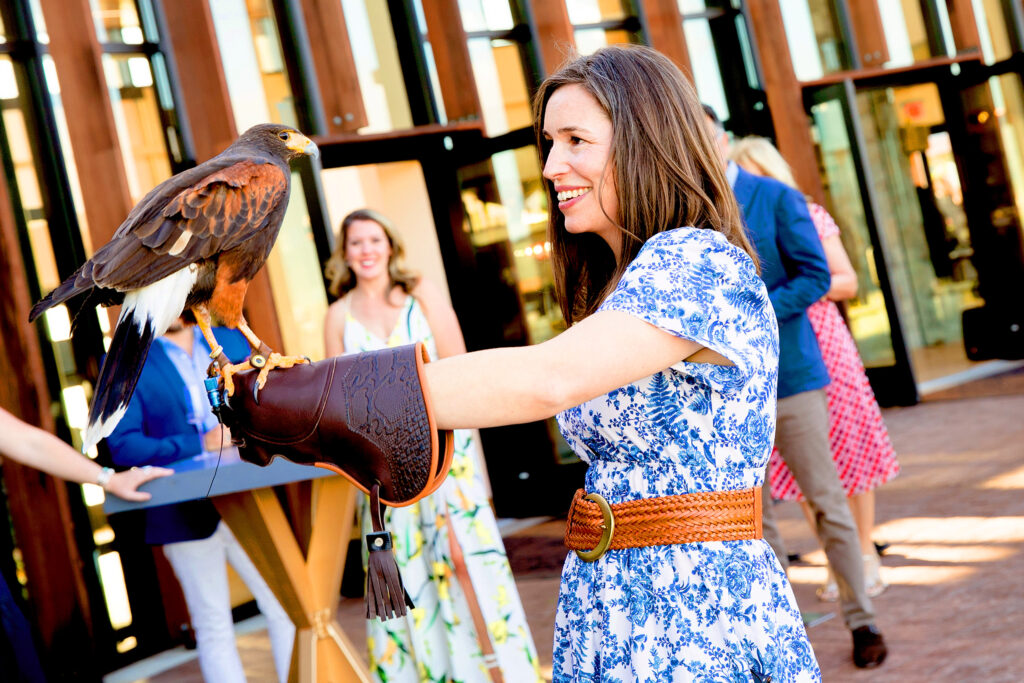
Bouchaine offers an array of interactive experiences, and one of the coolest is the Falconry in the Garden demonstration ($95). As part of its efforts to keep grape-eating birds at bay, a master falconer sends raptors into the vineyard to swoop in and scare the pests away. With a glass of wine in hand, visitors can meet the majestic falcons and watch them in action.
Bouchaine Vineyards, 1075 Buchli Station Road, Napa, 707-252-9065. Open daily, with reservations required for interactive experiences. bouchaine.com
Tina Caputo is a wine, food, and travel journalist who contributes to Sonoma magazine, SevenFifty Daily, Visit California, Northern California Public Media, KQED, and more. Follow her on Bluesky at @winebroad.bsky.social, view her website at tinacaputo.com, and email her story ideas at tina@caputocontent.com.
The post Bouchaine Vineyards Pays Homage to Burgundy in Wind-Swept Carneros appeared first on Sonoma Magazine.
]]>
Upon visiting the Napa winery, you may find yourself wondering, Bugs Bunny style, if you somehow took a wrong turn at Albuquerque.
The post Hudson Ranch and Vineyards Looks Like Arizona but Tastes Like Napa appeared first on Sonoma Magazine.
]]>









If you’re a fan of minerally and complex Napa Valley Chardonnay, there’s a good chance you’ve seen the Hudson Vineyard designation on a wine label. Along with making about 5,000 cases of wine under its own brand, Hudson Ranch and Vineyards sells its sought-after grapes to star producers like Kistler Vineyards, Patz & Hall and at least a couple-dozen more.
Lee Hudson’s path from deep in the heart of Texas to deep in the heart of Napa led him from his native Houston to the Arizona desert and through the vineyards of France. With a horticulture degree in hand from the University of Arizona, Hudson headed for Burgundy in the late ‘70s to learn about viticulture as an intern at Domaine Dujac. Working alongside founder Jacques Seysses, he came to understand the connection between exceptional vineyards and the world’s great wines.
Determined to grow grapes of his own, Hudson returned to the United States and earned a graduate degree in viticulture and enology at UC Davis. The next step was finding the right piece of land. His search led him across California, eventually landing him in the cool, windswept Carneros region. In 1981, he purchased a 2,000-acre ranch and founded Hudson Vineyards as a grape growing operation.
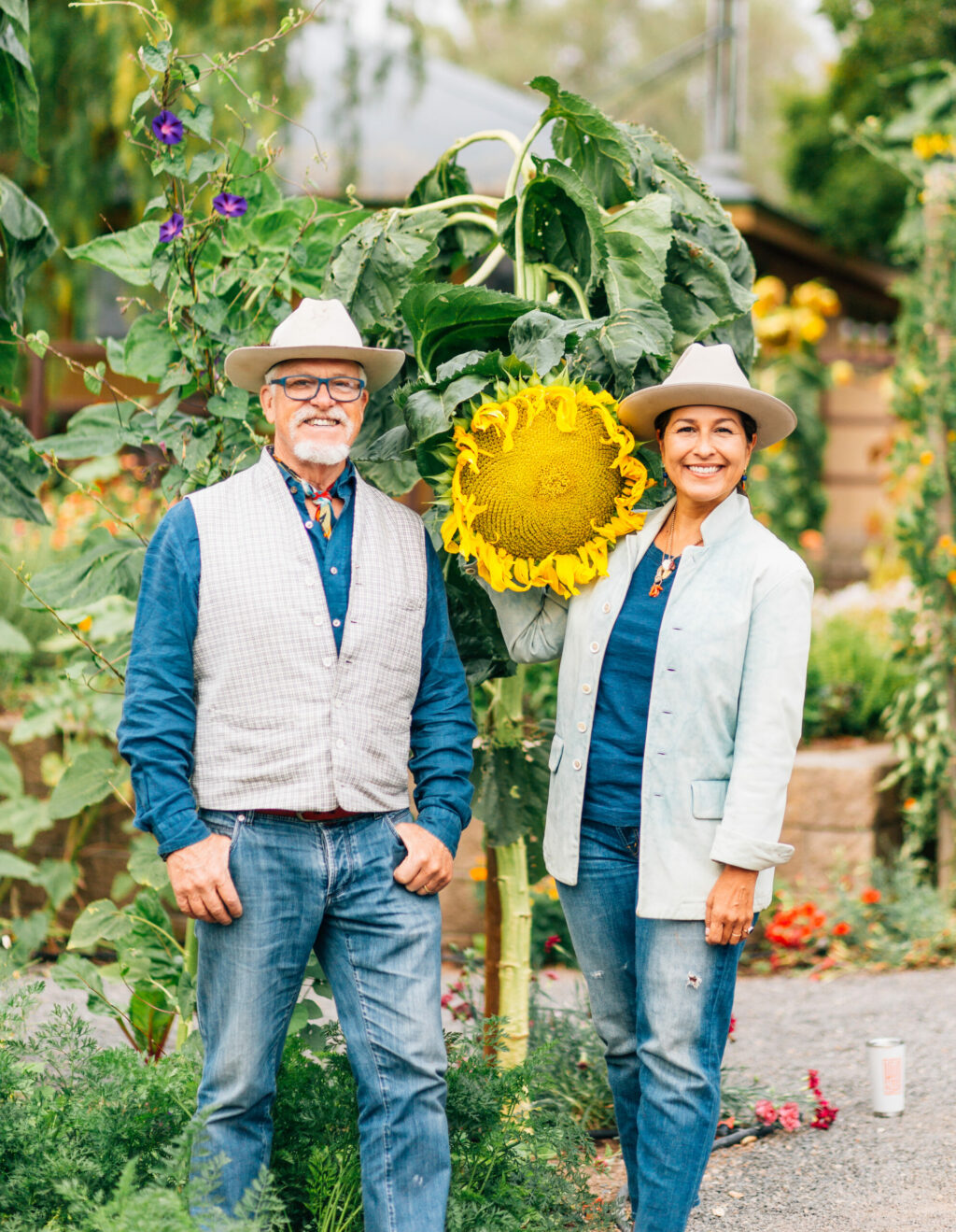
In 2004, he began producing his own wines under the Hudson label. The estate cultivates 200 acres of vines, including Chardonnay, Cabernet Sauvignon, Cabernet Franc, Merlot, Syrah and Grenache — most of which Hudson still sells to other wineries. A true agrarian at heart with a focus on holistic farming, he also grows an array of fruits and vegetables on the ranch, and raises heritage breed pigs, lambs and chickens.
The vibe
On first glance, Hudson Ranch looks a lot like other Napa Valley vineyard estates. But as you drive past the rows of grape vines toward the hospitality building, the scene begins to change. A collection of large agave and aloe plants line the picnic area overlooking a scenic pond, and human-sized cacti stretch their spiky heads skyward. You may find yourself wondering, Bugs Bunny style, if you somehow took a wrong turn at Albuquerque. This is Hudson’s horticulture background at play, and it’s like nothing else you’ll see in the Napa Valley.
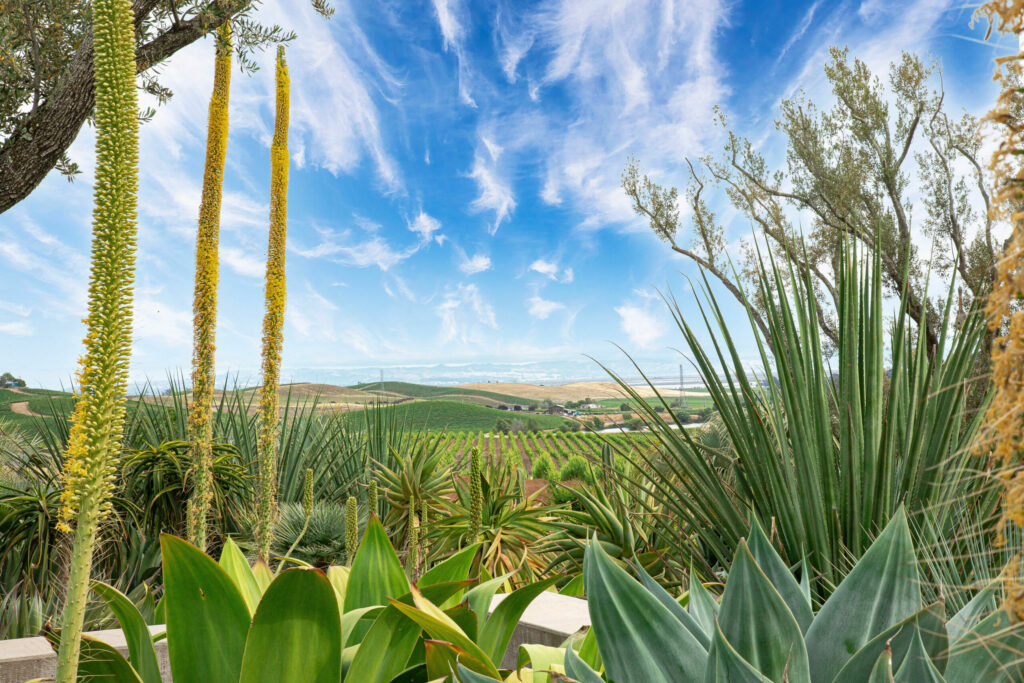
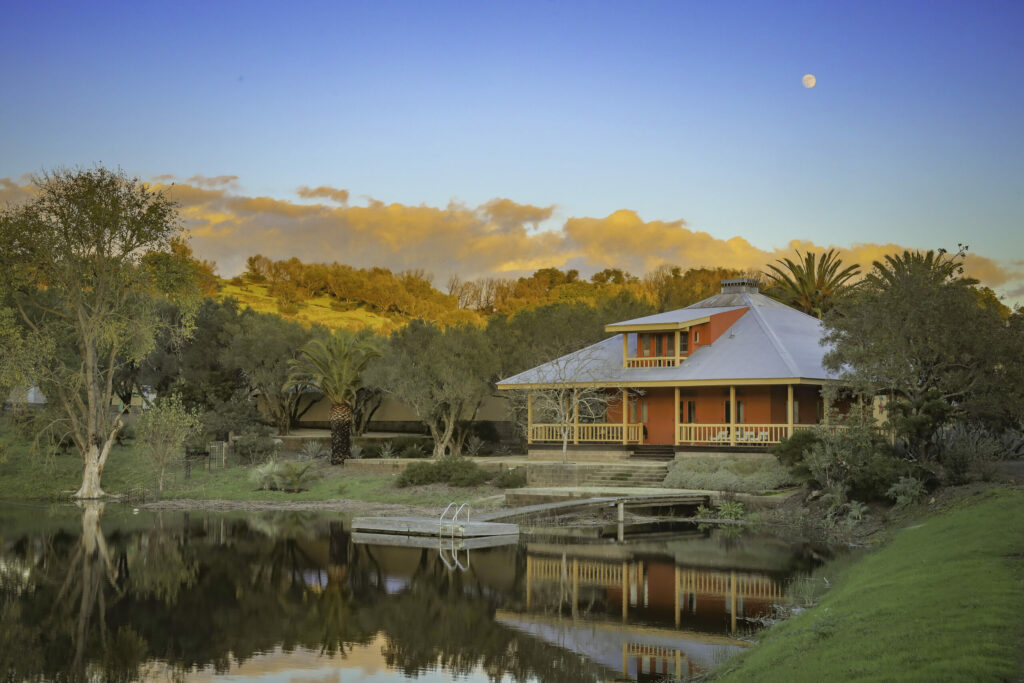
The contemporary hospitality building, built in 2018 along with the winery, displays items found on the ranch: tiny birds’ nests, fossils, the skulls of small animals. On the tasting patio out back, with its distant view of the vineyard-cooling San Pablo Bay, natural materials and colors meld with the starkly beautiful desert-meets-Napa landscape. The aesthetic, designed by Hudson’s wife Cristina Salas-Porras Hudson, incorporates the Japanese philosophy of wabi-sabi, which highlights simplicity and the natural beauty of imperfection.
On the palate
Hudson Ranch and Vineyards takes a let-the-fruit-do-the-talking approach to winemaking — which is just what you’d expect from grape growers. Chardonnay is queen at Hudson (they make three single-vineyard versions, plus an estate blend) and I dare any Chard-hater to taste theirs without falling in love.

The 2022 Little Bit Carneros Chardonnay ($115) is a splurge-worthy stunner with notes of stone fruits and citrus. The wine is lush in texture but doesn’t bonk you on the head with oak. For summer-in-a-glass vibes, try the juicy 2024 Carneros Grenache Rosé ($45). It smells like garden strawberries yet is surprisingly crisp and dry. The 2019 Phoenix ($85) is a seamless Merlot-driven blend that might just make you forget that Carneros is Pinot Noir country.
Seated tastings range from the Collector Experience ($100) to the Hudson-Arietta Experience ($150), which showcases wines made by Arietta winery from Hudson grapes. In between sips, guests snack on popcorn popped in duck fat and dunked in the winery’s estate olive oil. During summer months, tastings include a walk to the garden to see what’s ready for picking.
Beyond the bottle
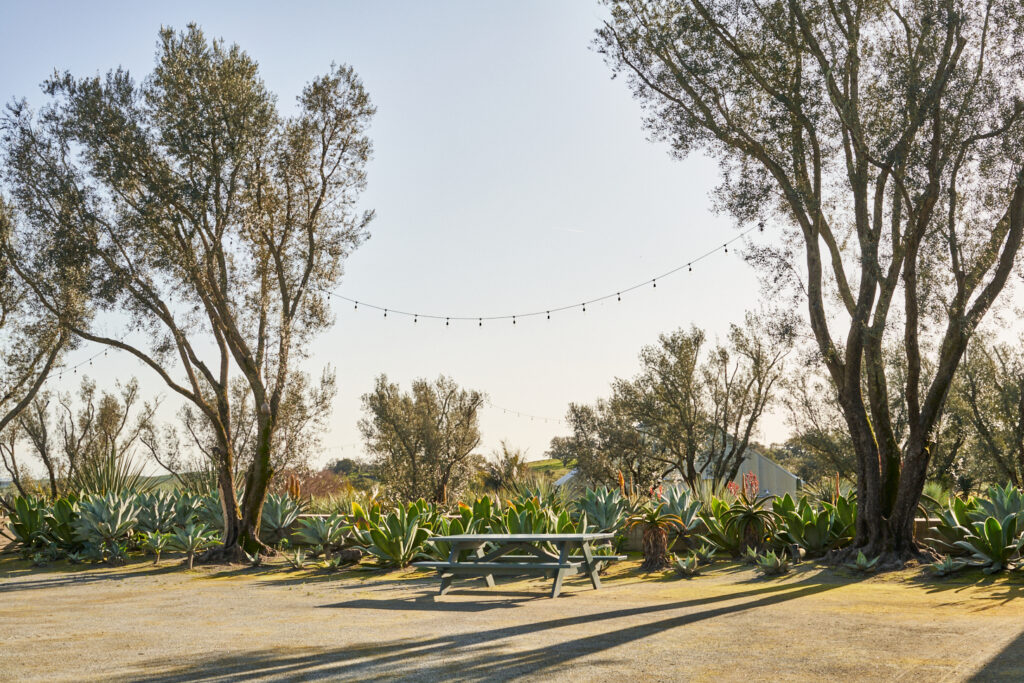
To sample more of the ranch’s bounty, take a 20-minute drive to Hudson Greens & Goods at Napa’s Oxbow Market. The family grocery store sells organic fruits and vegetables from the estate gardens, plus snacks and gourmet pantry items. If you’d rather spend more time on the ranch (and who wouldn’t?), add a self-guided hike to your tasting ($20) or reserve a picnic table ($50).
Hudson Ranch and Vineyards, 5398 Carneros Highway, Napa, 707-255-1345. Open daily with reservations. hudsonranch.com
Tina Caputo is a wine, food, and travel journalist who contributes to Sonoma magazine, SevenFifty Daily, Visit California, Northern California Public Media, KQED, and more. Follow her on Bluesky at @winebroad.bsky.social, view her website at tinacaputo.com, and email her story ideas at tina@caputocontent.com.
The post Hudson Ranch and Vineyards Looks Like Arizona but Tastes Like Napa appeared first on Sonoma Magazine.
]]>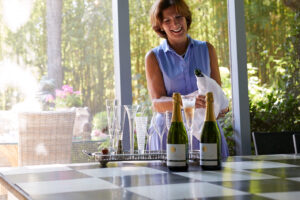
After Vintage Wine Estates filed for bankruptcy last year, Paula Kornell and some 30 other wine and spirits brands were left unprepared and facing the auction block.
The post When Vintage Wine Estates Collapsed, Paula Kornell Paved Her Own Path appeared first on Sonoma Magazine.
]]>









When Napa Valley winemaker Paula Kornell released her inaugural Brut Rosé in March, she was celebrating more than just a new addition to her small portfolio.
She was toasting her success in having any wine at all, after her partnership with Vintage Wine Estates collapsed the previous year (the partnership covered sales and distribution). The behemoth corporation suddenly filed for Chapter 11 bankruptcy in July 2024, leaving Kornell and some 30 other wine and spirits brands across California, Oregon and Washington unprepared and facing the auction block.
Some big names, like Sonoma County’s B.R. Cohn, Kunde and Viansa wineries, were quickly snatched up by new owners. But Paula Kornell Sparkling Wine, established just eight years ago and producing less than 20,000 cases annually across three wines, was a bit too boutique to be in the spotlight.
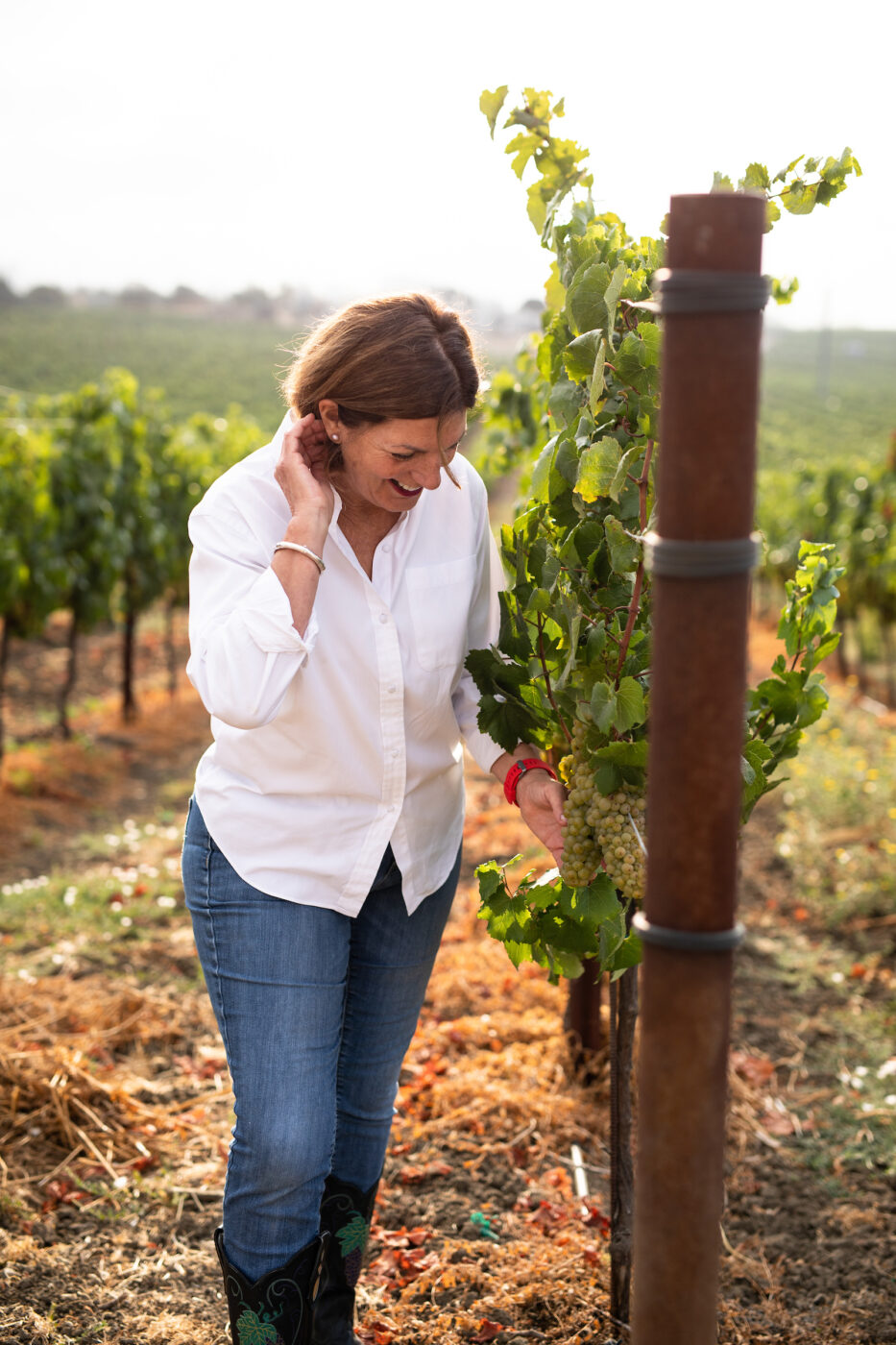
“It really was a shock to the whole wine community that it fell apart,” she said. “Vintage (Wine Estates) bought so many brands, and then I don’t think they put the love and care that all the brands needed. It shows that consolidation is not always for the best. These days, you need to have a great story to sell your wines and, in this marketplace, you really need to have the right (marketing and distribution) bandwidth behind it.”
Kornell tried not to panic during the transition.
“I will say that I was blessed with the fact that I had worked 10 years with Robert Mondavi, and they were a great marketing and sales organization,” she said. “I’m so glad I had that education there, because without that, I don’t know if I would have survived.”
Then, in November, Kornell found new partners, Mike and Jenny Farmer of Calistoga.
Mike Farmer, formerly the president of commercial operations at Builders FirstSource supplies and materials company, now serves on the board of directors for the Leukemia & Lymphoma Society.
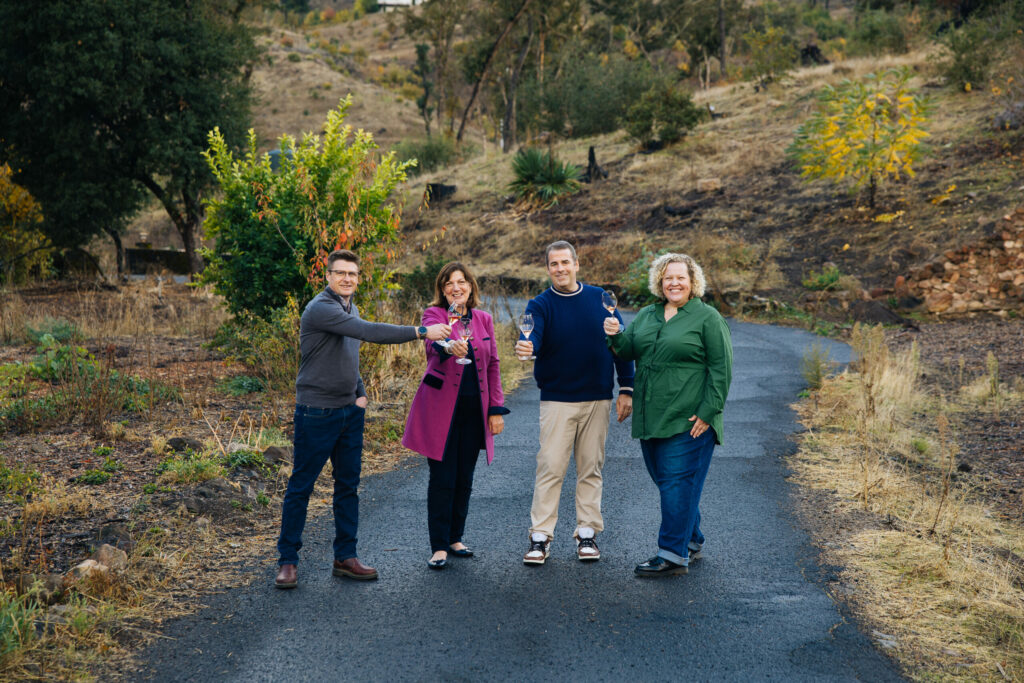
After nearly 20 years as a labor and delivery nurse, Jenny Farmer now serves on the board of Hope Scarves, an organization dedicated to raising funds for metastatic breast cancer research and patient support.
It was serendipity — the Farmers had been Kornell’s very first customers when she launched her inaugural vintage, a 2017 Napa Valley Blanc de Noir. The trio had bonded over their shared love of wine, dogs and commitment to charitable work. Kornell was the president of the board of directors for Napa Valley Vintners and served on the boards of Napa Humane and Queen of the Valley Medical Center in Napa.
“They (the Farmers) came to my home in St. Helena to drink bubbles with me,” she said. “I call my house Château Drool since I have three dogs. And they have bulldogs.”
The Farmers helped Kornell finish and launch her fourth sparkling, the California Brut Rosé.
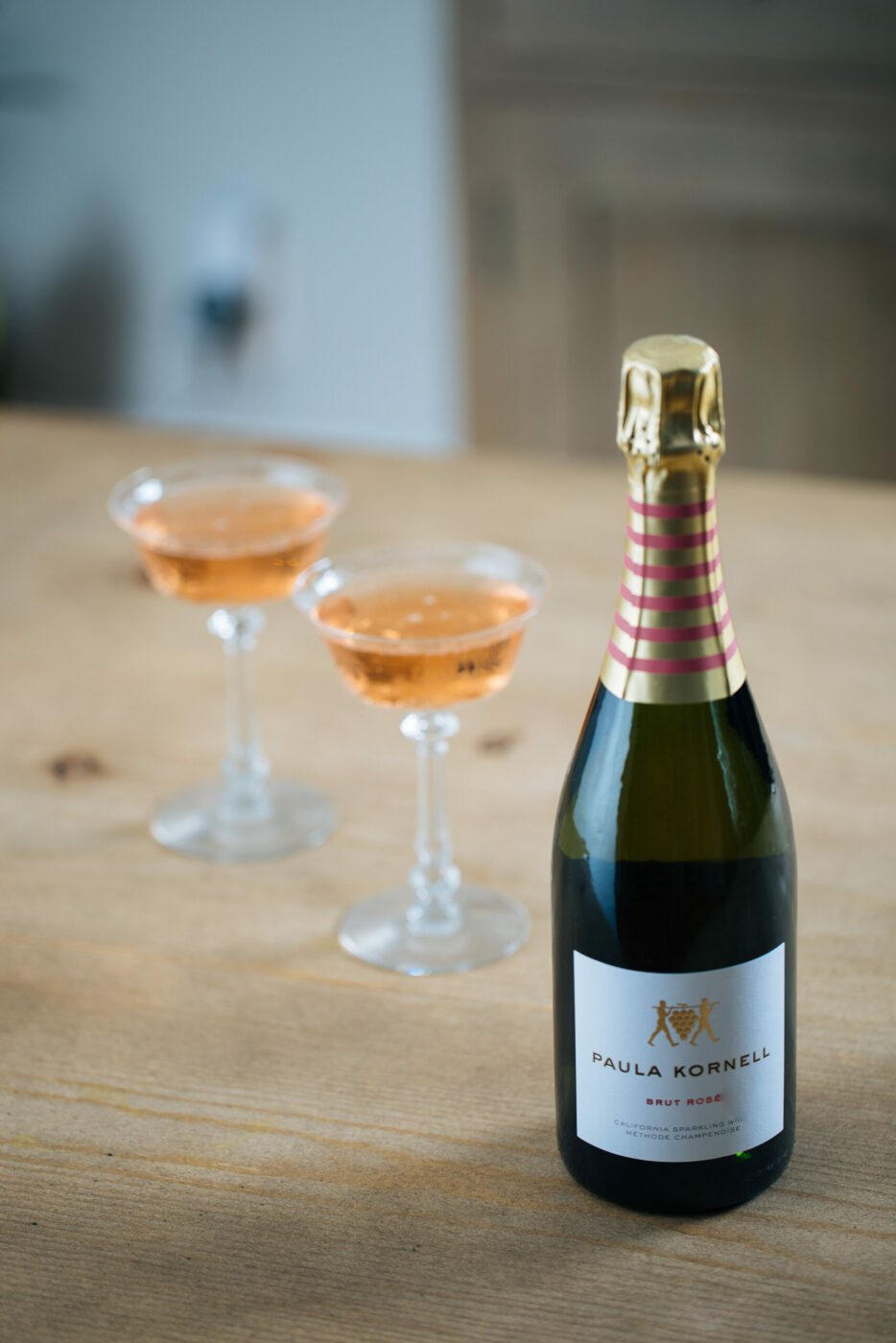
A personal and professional turning point
Losing her affiliation with Vintage Wine Estates was as much a personal loss as it was a professional one. Kornell’s father, Hanns Kornell — a third-generation German winemaker and Dachau concentration camp survivor — moved to New York in 1939, then hitchhiked to California, eventually leasing a winery in Sonoma in 1952.
Seven years later, he and his new wife — opera singer and doctor Marilouise Rossini — purchased the historic 1895 Larkmead Winery Estate in Napa Valley. They renamed the sprawling property Hanns Kornell Champagne Cellars, where they showcased the Méthode Champenoise sparkling style. (In 1992, the estate was purchased by Frank Family Vineyards.)
Paula Kornell always knew she would be in the wine industry. Born in 1959, she got her first job at 10, selling prunes and walnuts from her grandmother’s orchard and feathers from the family’s peacocks in front of the Hanns Kornell tasting room.
Her career trajectory led her to numerous roles at her parents’ winery, traveling the world and further training at prestigious hotels and wineries. Along the way, she met Vintage Wine Estates co-founder Pat Roney.
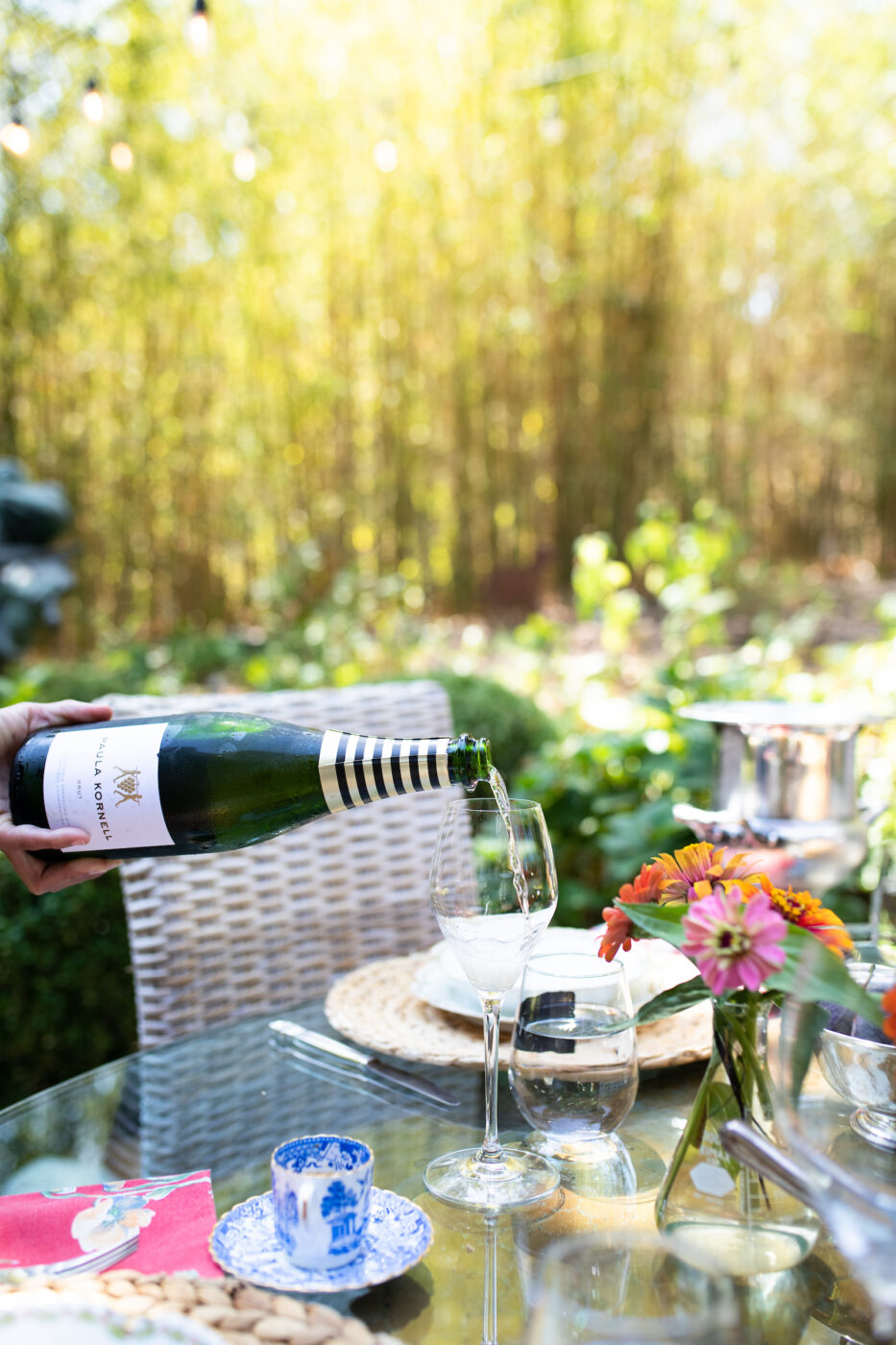
In 2014, she established a consulting business, Kornell Wine Company, yet quietly dreamed of creating her own label to share the sparkling wines she loves.
“I’d known Pat since the Hanns Kornell days, and when he suggested we do something together, it seemed like a great opportunity,” she said. “And it was. I was given an incredible opportunity to start my own brand, thanks to the boost that Pat gave me. Vintage (Wine Estates) truly left me alone to design and create what Paula Kornell Sparkling is today. It’s just so sad that they went under.”
But Kornell now believes the change propelled her toward greater happiness.
“Mike and Jenny are such great friends and they were aware of all the trials and tribulations I was going through. They kept saying they wanted to help, and sure enough, now they are my new partners. So, I am really very, very lucky.”
Paula Kornell Sparkling Wines, paulakornell.com
The post When Vintage Wine Estates Collapsed, Paula Kornell Paved Her Own Path appeared first on Sonoma Magazine.
]]>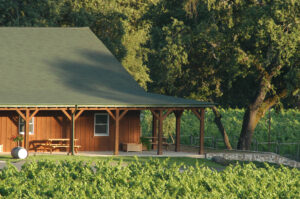
Wooden tables dot a large patio overlooking Napa Valley vineyards, inviting guests to slow down and get comfortable.
The post Hendry Ranch Is Doing It Old School in Napa appeared first on Sonoma Magazine.
]]>









Napa is justifiably famous for its Cabernet Sauvignon and Chardonnay, but in the region’s early days — before skyrocketing land prices made it practically impossible to justify growing grapes that didn’t command the highest prices — the valley’s offerings went far beyond the “king” and “queen” of noble grapes. Hendry Ranch offers a welcome taste of variety on a charming estate at the foot of Mt. Veeder, farmed by the same family for more than 85 years.
The story
Hendry Ranch got its start in 1939, when agronomy professor George W. Hendry bought a 200-acre property in Napa and moved there with his wife Margaret. When George died just five years later, Margaret took over managing the farm, growing plums, walnuts and grapes — all while raising their two children. Having grown up on the family ranch, their son George O. Hendry followed a somewhat unexpected career path: He became a designer of cyclotrons used in medical imaging. Any free time he had, he spent working on the farm.
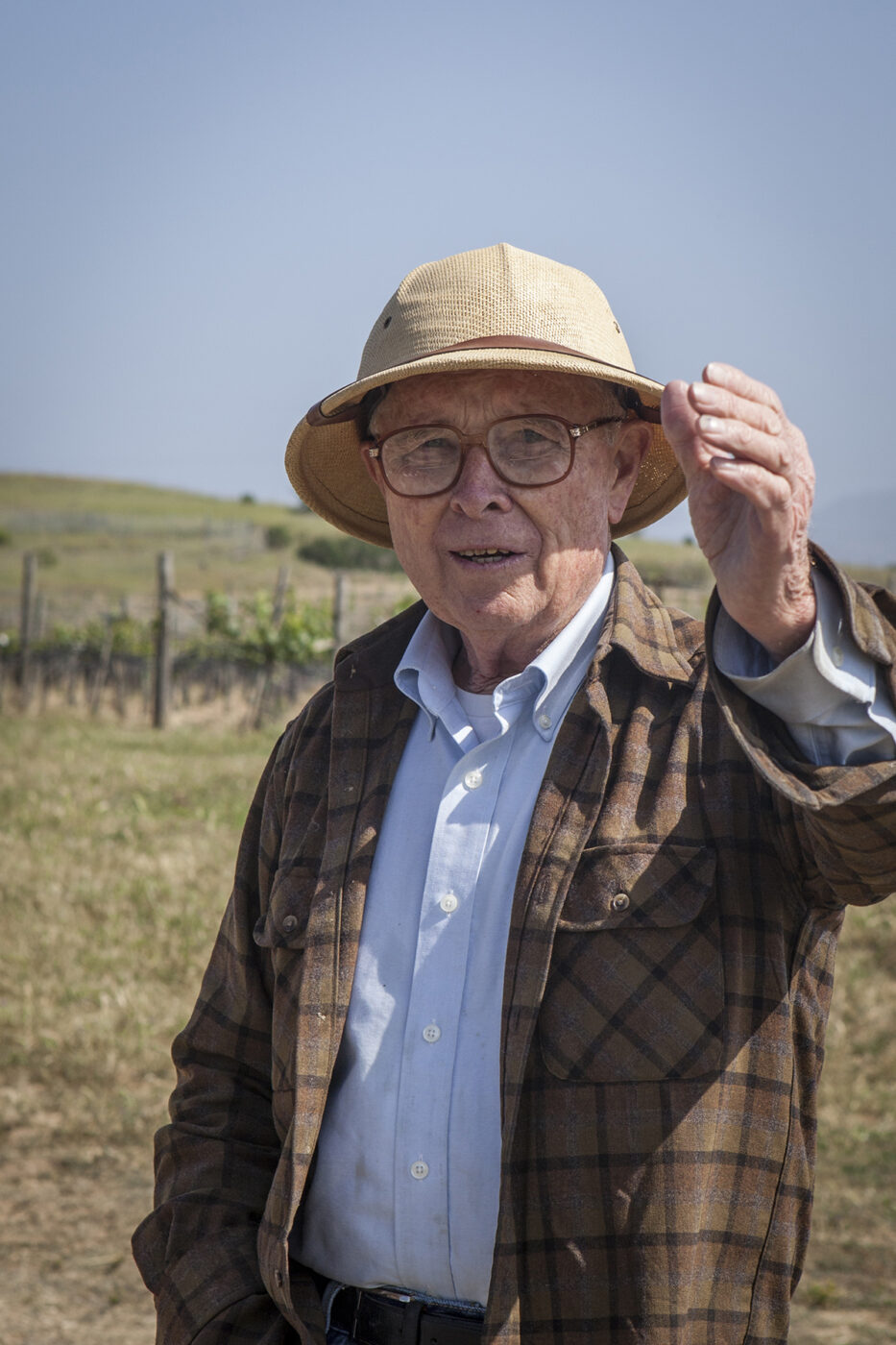
By the early 1970s, with Napa’s wine industry on the rise, Hendry realized he could make more money selling wine grapes than he would bring in with prunes and walnuts. He replanted most of the ranch to grapes, starting with Zinfandel and Pinot Noir, and began selling the fruit to Robert Mondavi and Kent Rosenblum. He made his first wine in 1992 and built the winery eight years later.
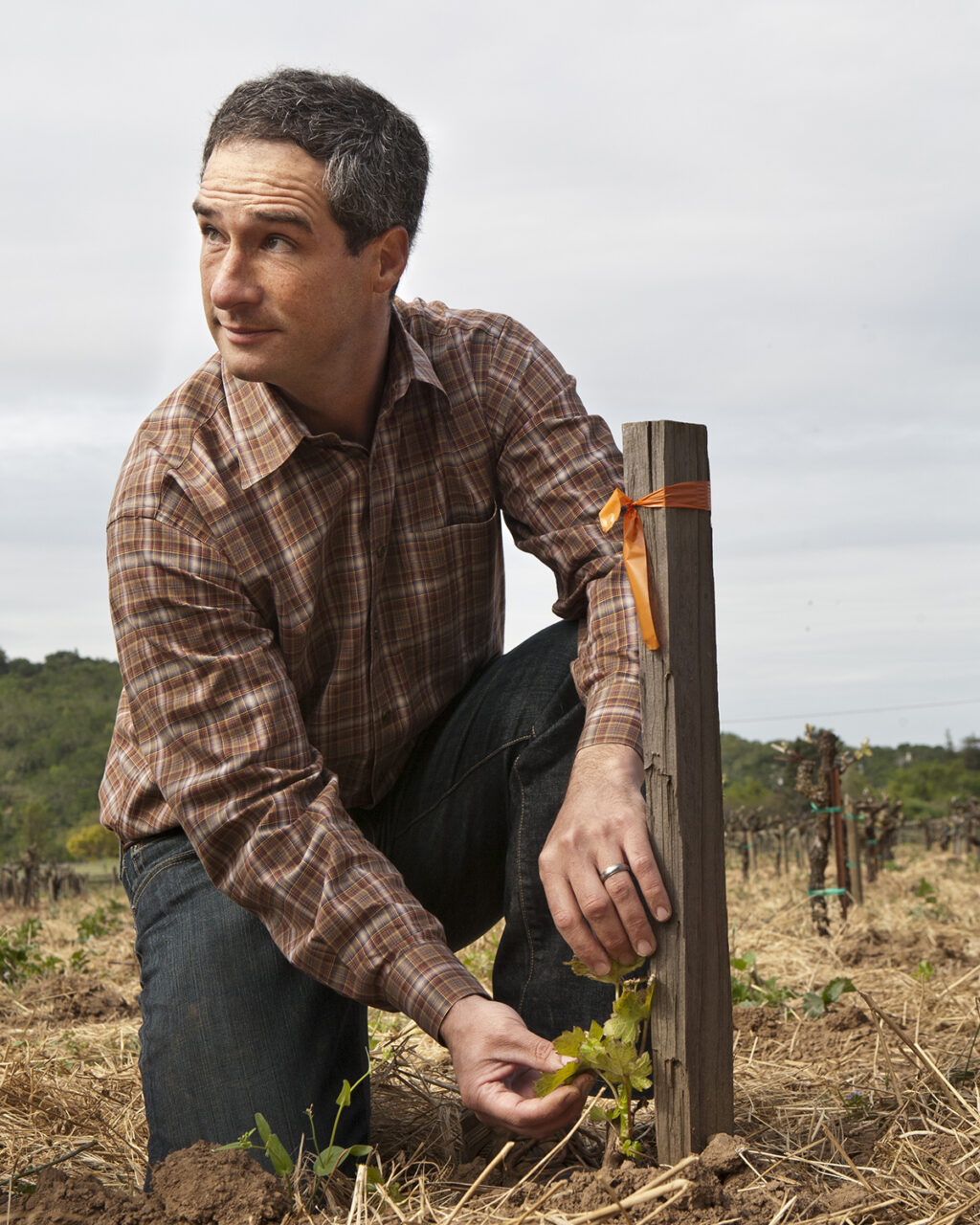
Hendry — now in his 80s — still lives on the property, just a short walk from the winery. His nephew, Mike Hendry, manages the ranch’s 114 acres of vines, including many grape varieties you don’t often find in Cabernet-centric Napa these days, like Primitivo, Albariño and a tiny bit of Mission.
The vibe
Driving through residential Browns Valley, most people wouldn’t expect to find a vineyard estate. Look for the understated sign that marks the entrance to Hendry Ranch, then drive past George Hendry’s big white house to the brown tasting room building.
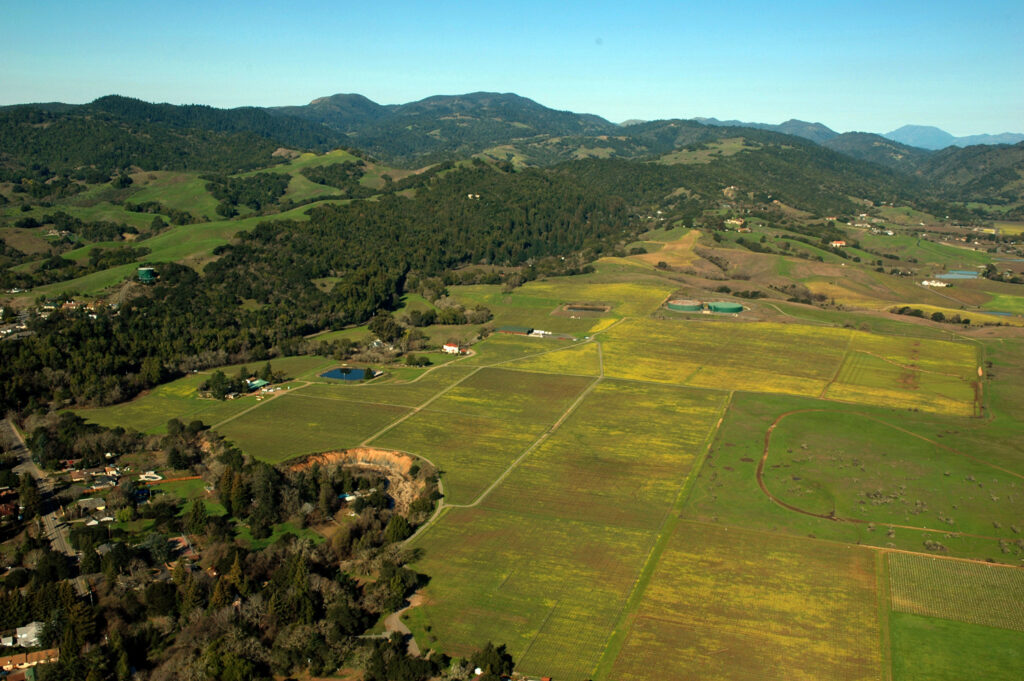
Wooden tables dot a large patio overlooking the vines, inviting guests to slow down and get comfortable. The bright and airy indoor space, decorated with warm wood accents and Hendry family artifacts, includes various rooms for seated tastings. Hendry often pops in to say hello, accompanied by Gracie, his sweet Chihuahua mix.
On the palate
Hendry grows a dozen grape varieties, so there’s a lot to explore. Albariño has recently become “a thing” in the U.S., but you won’t find many made in Napa Valley. George Hendry was way ahead of the curve, planting it on the ranch in 1997.
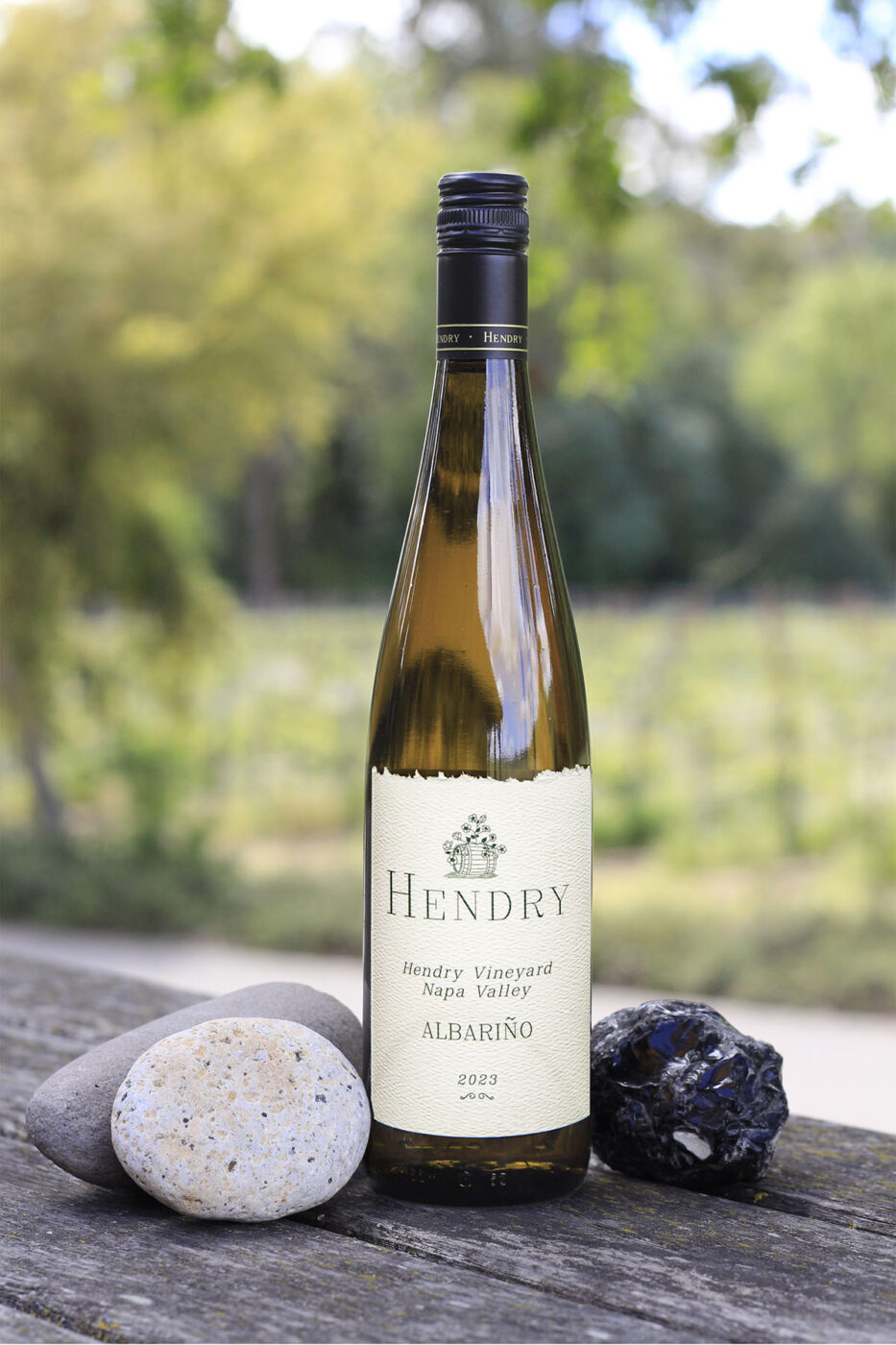
Hendry’s 2023 Albariño ($28) is a lively summer sipper with peachy notes. It’s fun to compare the 2023 Unoaked Chardonnay ($28) and 2023 Barrel Fermented Chardonnay ($40). The wines are made with the same grapes and share a tangy green apple profile, but the oak adds soft vanilla aromas and a creamy texture. A standout among the reds is the elegant 2021 Primitivo ($42) with its cherry-berry flavors.
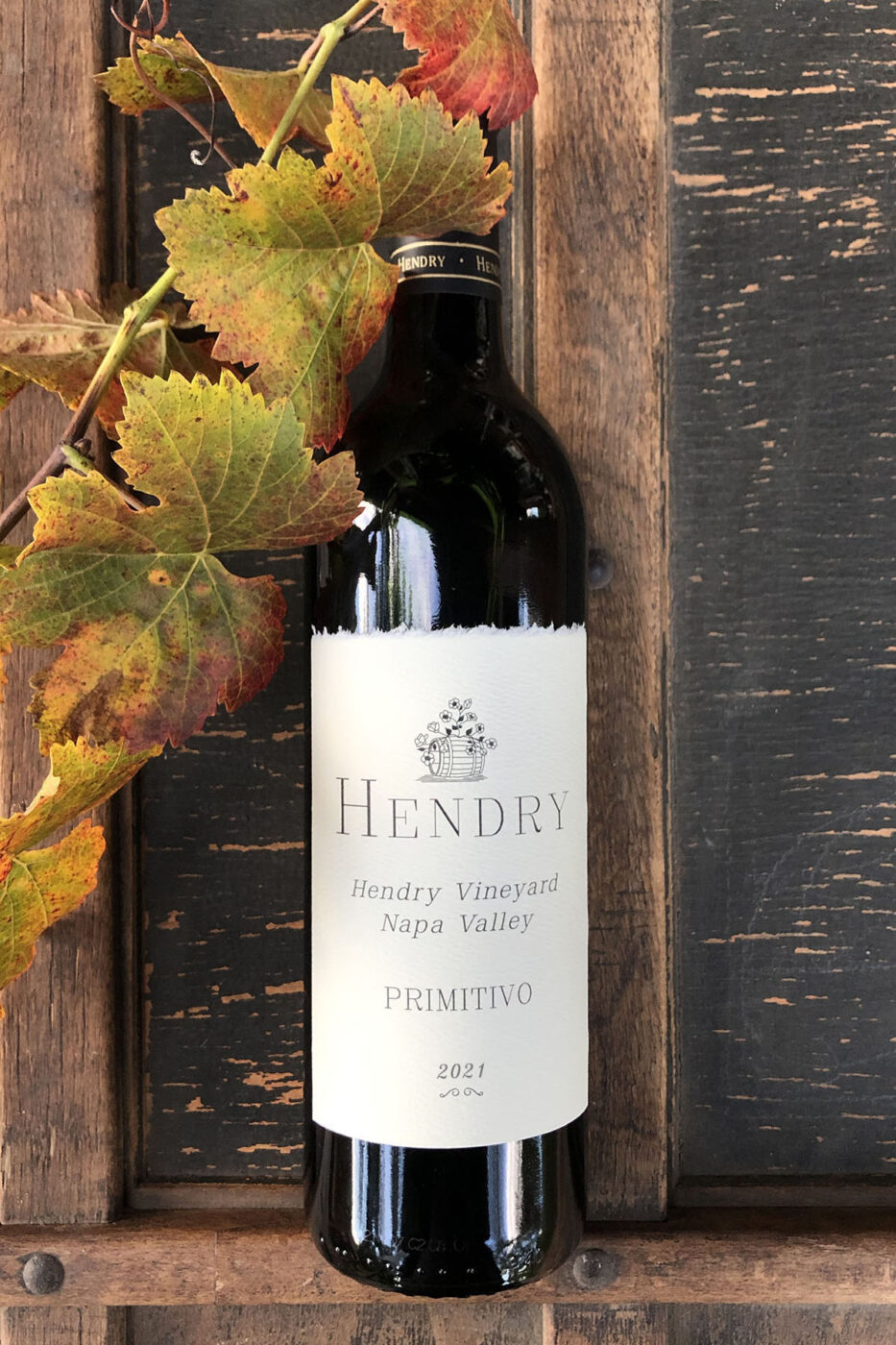
Tastings range from $50 for a red wine flight to $75 for a mixed tasting to $100 for a flight of reserve wines. (All fees are waived with an equivalent wine purchase.) Because appointments are private affairs with an expert guide, the tasting lineups often vary according to guests’ interests. You might even get a quick lesson in grafting grape vines.
Beyond the bottle
I love a gourmet market, and locally owned Browns Valley Market is a neighborhood gem. It’s known for its meat section, so this is the place to grab steaks or a marinated tri-tip to pair with Hendry’s excellent Zinfandel or Cabernet Franc. The deli offers a terrific selection of grill-and-go panini to take along on a Wine Country picnic.
3104 Redwood Road, Napa, 707-226-8320. Tastings daily by appointment. hendrywines.com
Tina Caputo is a wine, food and travel writer whose work has appeared in numerous publications, including SevenFifty Daily, Visit California, HuffPost and Sonoma magazine. Follow Tina on Twitter @winebroad, view her website at tinacaputo.com and email her story ideas at tina@caputocontent.com.
The post Hendry Ranch Is Doing It Old School in Napa appeared first on Sonoma Magazine.
]]>
The winery is a magnet for a hip, younger crowd — but also feels comfortingly familiar to those of us who remember watching reruns of “The Brady Bunch” after school.
The post Ashes & Diamonds Is Still the Coolest Kid in Napa appeared first on Sonoma Magazine.
]]>









When Ashes & Diamonds arrived on the scene nearly eight years ago, it was almost like an act of revolution. Deliberately foregoing the “faux Château” architecture and riper-is-better approach embraced by many wineries at the time, the Napa newcomer made a splash with its midcentury-inspired style and classically restrained wines.
The story
Kashy Khaledi spent most of his adult life working as a creative director in multimedia and advertising, including stints at Live Nation and Capitol Records, before turning his visionary talents to wine. The son of Darioush Winery founder Darioush Khaledi, he’d come to admire the new crop of California winemakers embracing organic and biodynamic farming practices, and he had a special love for Napa wines from the ‘60s and ‘70s. With Ashes & Diamonds, Khaledi set out to create modern-day renditions of the elegant, low-alcohol wines that filled his cellar. He opened the winery — named for the 1958 Polish film that inspired his life-altering career move — in 2017.
The vibe
By design, the Ashes & Diamonds winery looks like a stylish throwback to another era. Set along Highway 29, next to Don Giovanni, the place has a light and breezy aesthetic that’s more Palm Springs than typical Napa Valley. Los Angeles architect Barbara Bestor collaborated with Khaledi to conceive the boxy white building, with its wall-sized windows, zigzag roof and playful portholes. In contrast to his parents’ opulent winery up the road, inspired by the ancient city of Persepolis in the family’s native Iran, Ashes & Diamonds is all clean lines and minimalist decor.
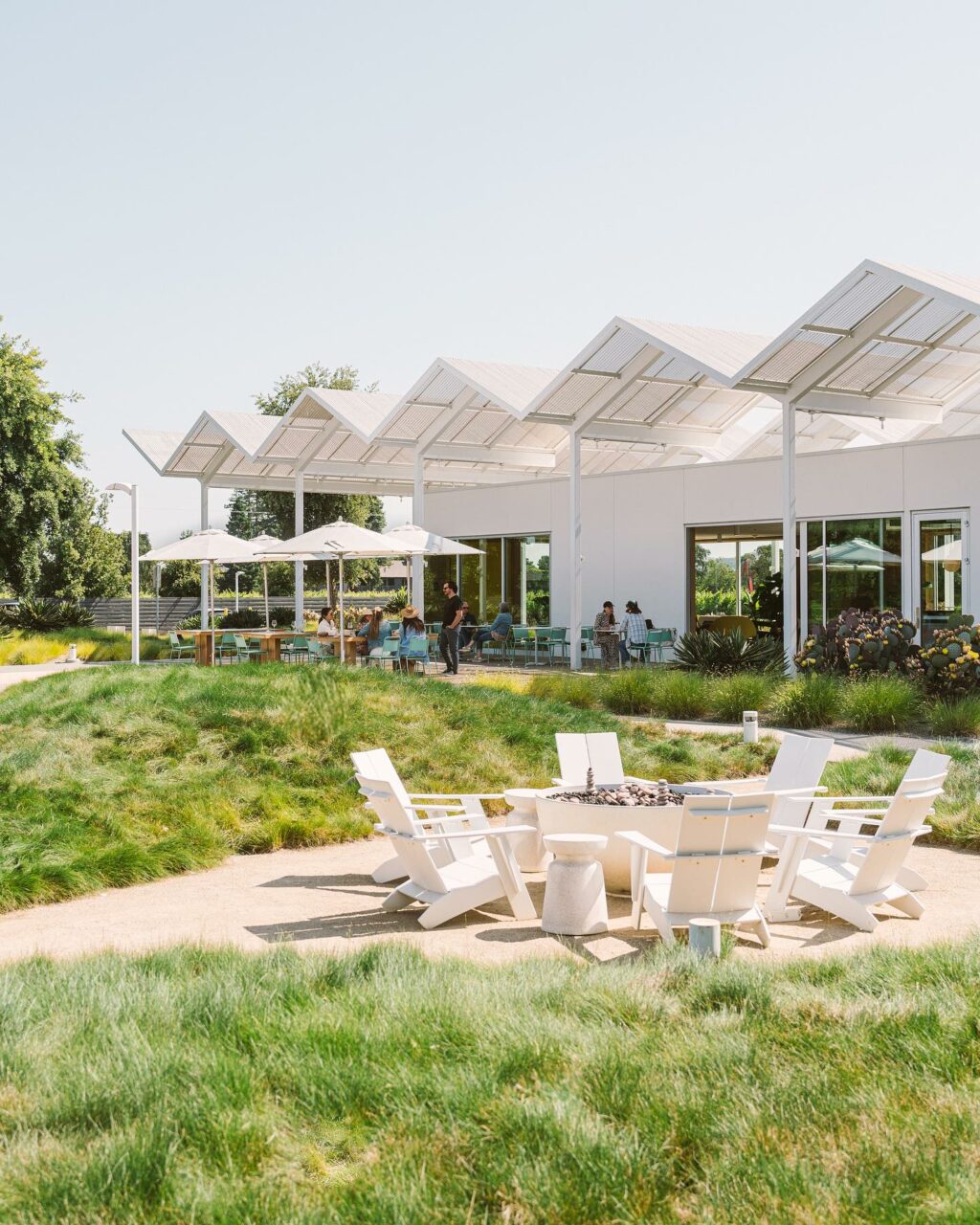
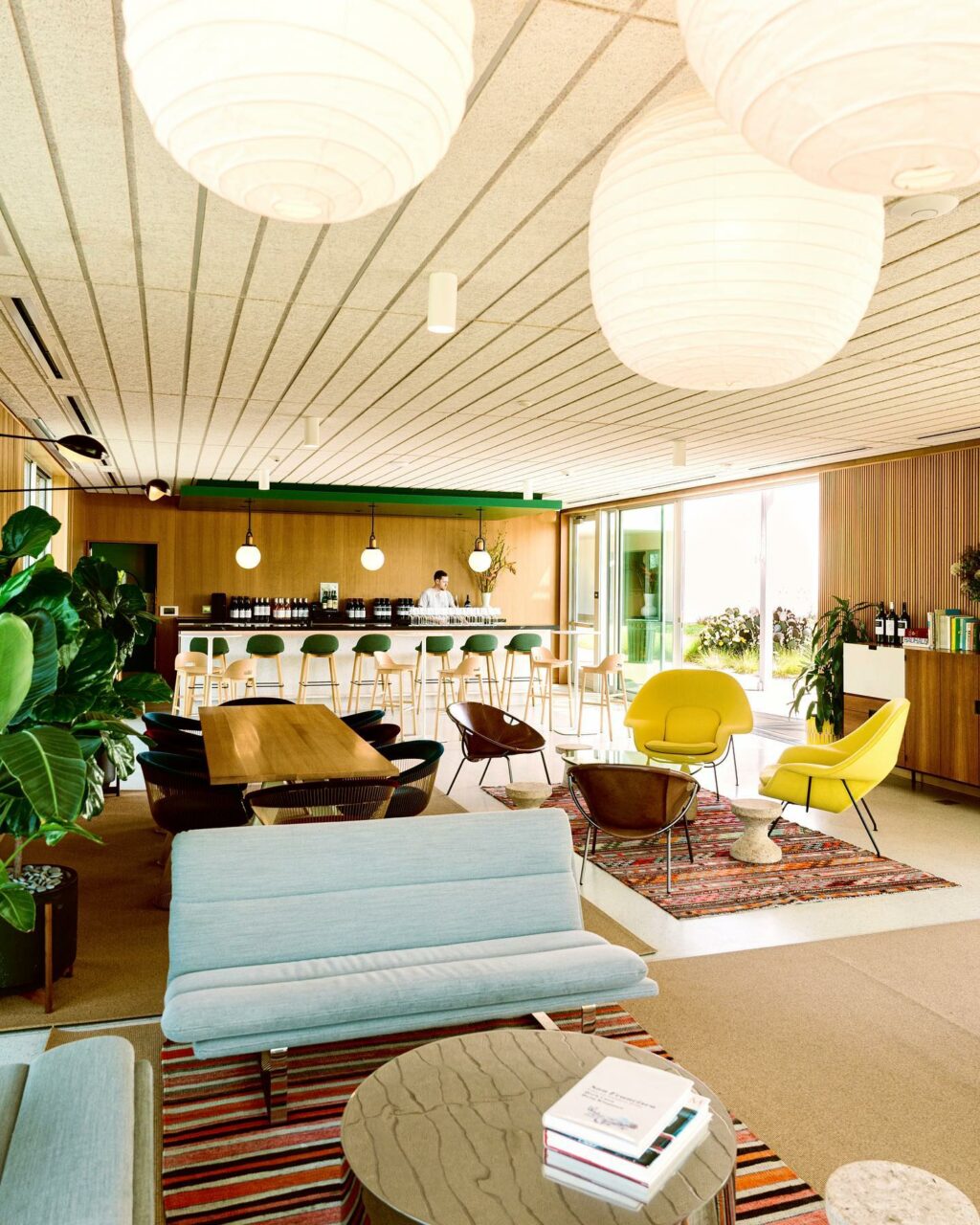
Enter through the oversize yolk-yellow door and you’ll find an open space outfitted with curvy midcentury modern chairs and sofa seating. From its potted plants to its ‘70s playlists, everything is carefully curated to create a relaxed, lighthearted atmosphere. This makes the winery a magnet for a hip, younger crowd — though its style also feels comfortingly familiar to those of us who remember watching reruns of “The Brady Bunch” after school.
On the palate
Ashes & Diamonds wines are “classic California,” before oak and alcohol levels began creeping up. Taking a divide-and-conquer approach, the wines are crafted by a trio of winemakers: minimalist Steve Matthiasson, Diana Snowden Seysses, who makes wine in Burgundy as well as California, and sparkling wine innovator Micheal Cruse. The wines, which hail from the Ashes & Diamonds Vineyard in the Oak Knoll District as well as other sites in Napa and the Santa Cruz Mountains, are lower in alcohol than many Napa offerings, with less emphasis on new oak.
Try the chillable 2023 Rosa ($45), a deeply colored blend of Cab Franc and Sangiovese that tastes like a grown-up version of Hawaiian Punch — and I mean that as a compliment. I’m especially smitten by the 2021 Napa Valley Cabernet Franc No. 8 ($80), which skillfully balances fruit and acidity for optimal food compatibility (looking at you, duck carnitas!).
Tastings range from $45 for a three-wine teaser of club-only wines to $175 for the excellent A&D Wines + Food family style lunch. This season’s menu features incredible housemade focaccia with mushroom butter, plus squash spaetzle, and chicken schnitzel with tahini rémoulade.
Beyond the bottle
Keep it low key with a post-tasting hang at Napa Yard at Oxbow Gardens. The dog-friendly beer garden along the Napa River was made for lawn games, tasty tacos and chilling around fire pits.
Ashes & Diamonds, 4130 Howard Lane, Napa. Open daily. ashesdiamonds.com
Tina Caputo is a wine, food, and travel writer whose work has appeared in numerous publications, including SevenFifty Daily, Visit California, HuffPost, and Sonoma magazine. Follow Tina on Twitter @winebroad, view her website at tinacaputo.com, and email her story ideas at tina@caputocontent.com.
The post Ashes & Diamonds Is Still the Coolest Kid in Napa appeared first on Sonoma Magazine.
]]>
A gorgeously Gothic Victorian mansion in St. Helena sets the stage for dark and brooding reds.
The post Faust Haus Is a Devilishly Good Place to Taste Wine appeared first on Sonoma Magazine.
]]>









If you’ve never heard the tale of “Faust,” it goes something like this: A discontented scholar makes a pact with the devil, trading his soul for limitless knowledge and worldly pleasures. (Spoiler alert: It does not go well for our tragic hero.) Named for the centuries-old legend, Faust Wines in St. Helena delivers on earthly delights — without the fiery consequences.
The story
Agustin and Valeria Huneeus, of Quintessa and Flowers fame, founded Faust Wines in 1998 and released the first wine in 2002. To support the brand, they planted more than 100 acres of Cabernet Sauvignon in what is now the Coombsville appellation — a cooler region at the southeast end of Napa. The Huneeus family found a dedicated home for Faust when St. Clement winery abruptly closed in 2016. After years of renovations on the 1870s mansion that formerly served as St. Clement’s tasting room, they opened Faust Haus in the fall of 2020.
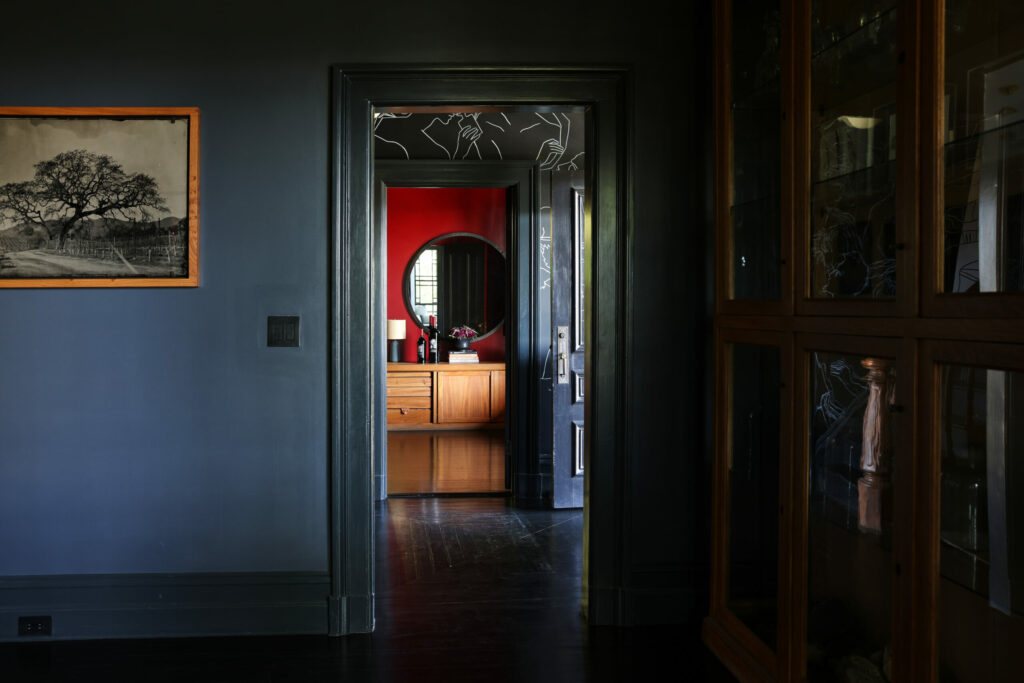
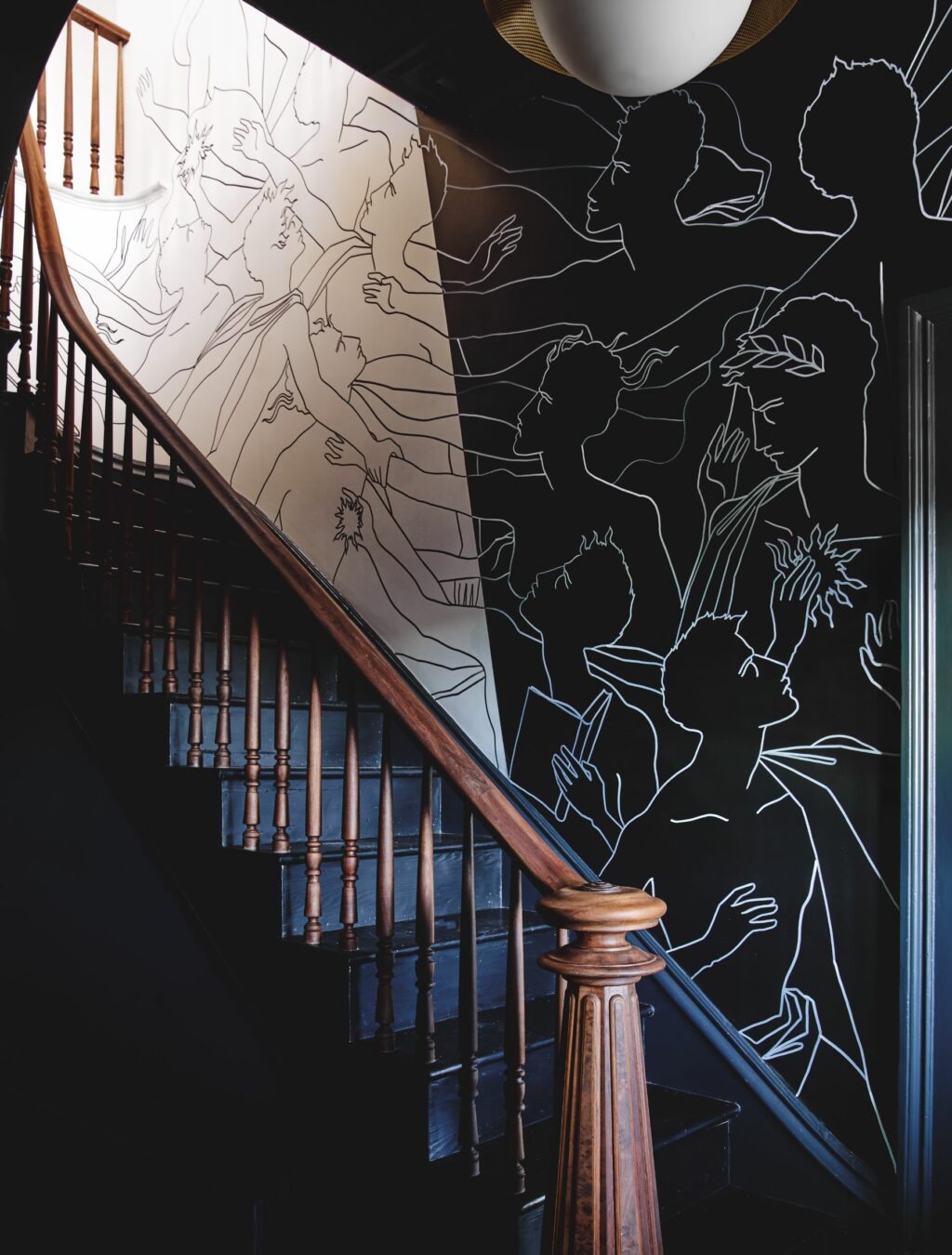
The vibe
It’s easy to spot Faust Haus from Highway 29. It’s the black Victorian mansion on the hill, just a half mile north of the Culinary Institute of America.
Everything about the building’s design whispers the story of Faust, from its black exterior to the darkness-to-light theme that runs throughout the house. The cellar, rumored to have operated as a speakeasy during Prohibition, is a dimly lit, intimate space with stone walls and lounge seating. The mood begins to lighten up on the main floor, which features a series of rooms with deeply colored blue and red walls, and plush chairs in electric blue.
Head up the staircase, pausing to admire the hand-drawn mural by Parisian artist Roberto Ruspoli, and you’ll reach the “heavens.” Adorned with white paint and contemporary blonde wood furniture, this top-floor tasting space is bathed in light. The outdoor terrace is almost as impressive, with its custom-designed, midcentury furniture and hilltop views across Highway 29 and the valley below.
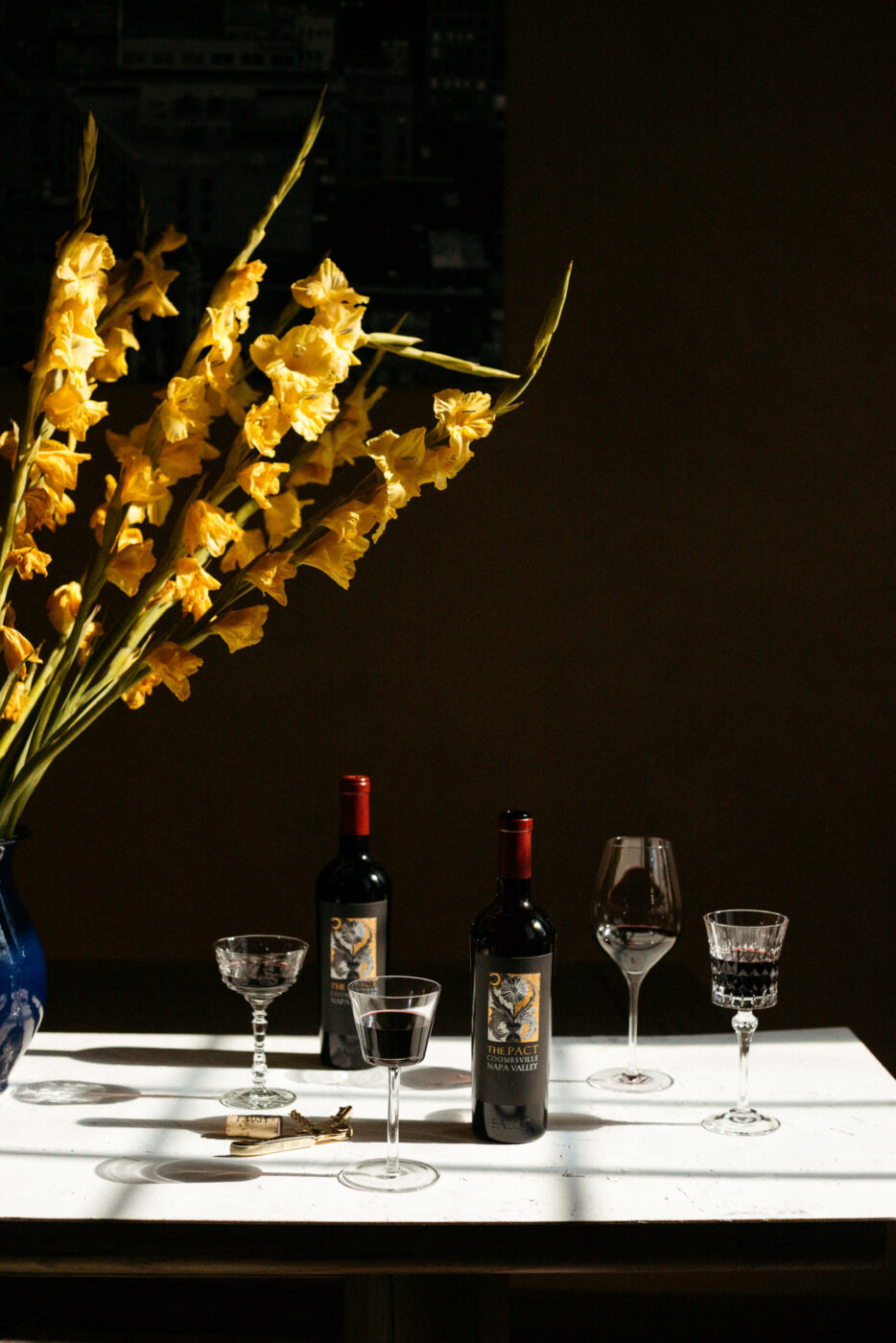
On the palate
The winery’s lineup includes two labels: the nationally distributed Faust and The Pact, a smaller-production brand focused on Coombsville estate fruit. The 2022 Faust Napa Valley Cabernet Sauvignon ($65) is bold and concentrated, with black cherry fruit and impressive balance. The Pact 2021 Coombsville Cabernet Sauvignon ($125) is a deep and complex wine that shows off sweet and savory aromas, plus rich blueberry and black cherry flavors. The Lure 2021 Coombsville Merlot ($90) might just be my favorite, with its plush texture, aromas of tobacco spice and plummy fruit flavor.
Tastings range from $75 for a sampling of limited-production estate wines to $150 for an immersive experience that includes a tour of the property, barrel tasting, library wines, and pairings with local cheeses and charcuterie. The Winter in the Winery tasting ($100), offered on Fridays and Saturdays, features an array of artisan charcuteries, cheeses and housemade snacks.
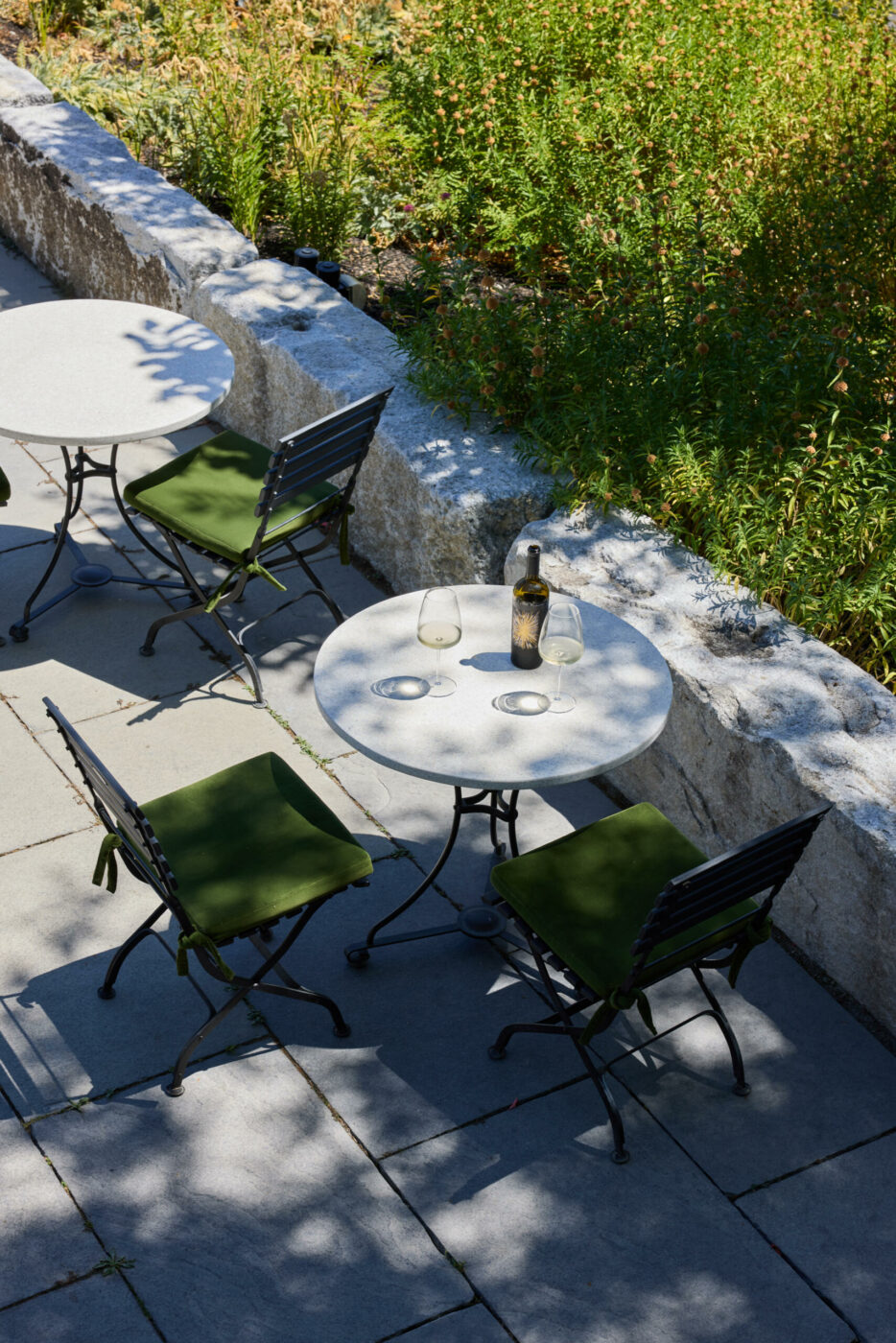
Beyond the bottle
To continue exploring stately mansions, have lunch at Violetto, set inside a 1907 Georgian-style home at the nearby Alia Napa Valley resort. The restaurant showcases modern food from Northern Italy, and it even offers a lunchtime tasting menu. Go for the griddled mortadella sandwich with charred broccoli rabe from the à la carte offerings. Or, if you’re in the mood to linger, choose the three-course prix fixe ($45 per person).
Faust Wines, 2867 St. Helena Highway, St. Helena. 707-200-2560, faustwines.com
Tina Caputo is a wine, food and travel writer whose work has appeared in numerous publications, including SevenFifty Daily, Visit California, HuffPost and Sonoma magazine. Follow Tina on Twitter @winebroad, view her website at tinacaputo.com, and email her story ideas at tina@caputocontent.com.
The post Faust Haus Is a Devilishly Good Place to Taste Wine appeared first on Sonoma Magazine.
]]>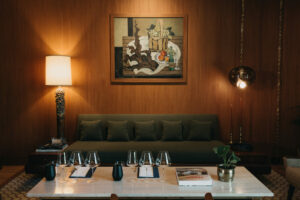
Mountaintop views and a stylishly designed tasting room await at this historic Spring Mountain winery in St. Helena.
The post Revamped Napa Winery Combines Classic Wines and Midcentury Glamour appeared first on Sonoma Magazine.
]]>









Credited with planting Napa Valley’s first Chardonnay vines in 1948 and opening one of the valley’s first post-Prohibition wineries in 1951, Stony Hill has spent more than seven decades championing lean white wines. Now, nearly four years into new ownership, the winery is moving into the modern age with a revamped tasting room and a refined interpretation of its legendary house style.
When Fred and Eleanor McCrea bought an old goat ranch on Spring Mountain in 1943, the couple envisioned a summer home at the site. But Fred soon came to believe that the high-elevation property, with its volcanic mountain soils and limestone sublayer, would be ideal for producing Burgundian-style Chardonnay and racy Riesling. He was right.
Stony Hill released its first wine in 1954 and the winery went on to become a cult favorite for its mineral-driven whites. Long Meadow Ranch picked up a majority stake in the winery in 2018, and two years later, Heitz Cellar owner Gaylon Lawrence Jr. and CEO Carlton McCoy Jr. bought Stony Hill. Along with the McCrea family’s historic Chardonnay, Gewürztraminer and Riesling plantings, the estate’s certified-organic vineyards now include Cabernet Sauvignon, Merlot and Syrah.
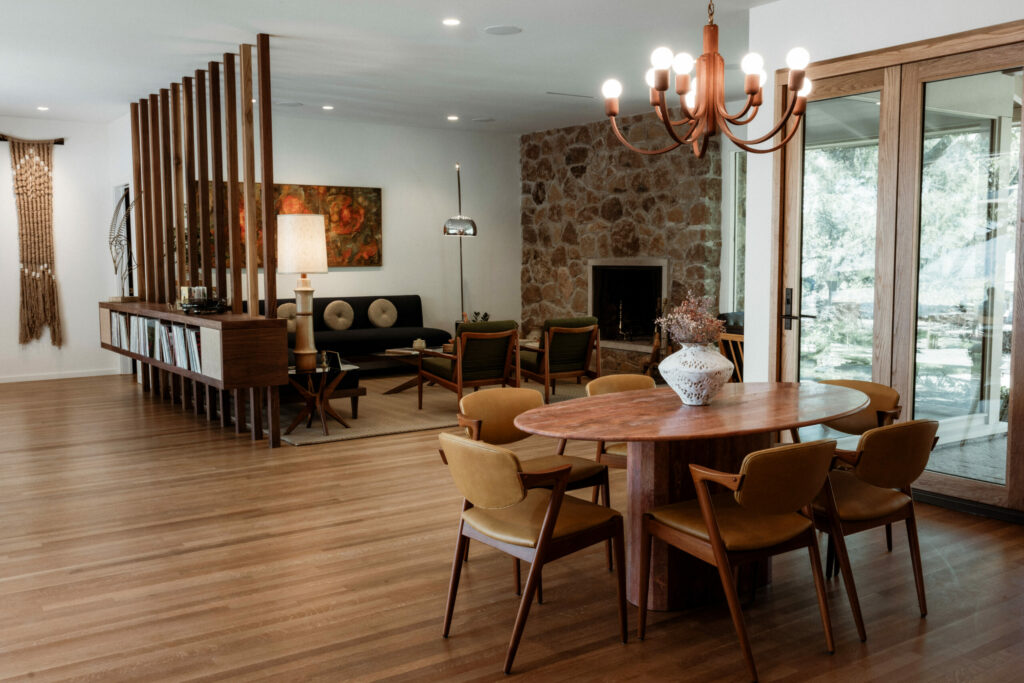

The vibe
Stony Hill sits in a remote location between St. Helena and Calistoga, within Bothe-Napa Valley State Park. As you wind your way up a steep one-lane road, you may find yourself wondering if you’ve somehow taken a wrong turn. When you get to the top of the hill, you’ll spot the midcentury home that serves as the winery tasting room.
Don’t be fooled by the structure’s understated appearance; in 2022-23, the McCrea family’s original 1951 home received a luxurious makeover. The revamped space includes a stylish living room lounge where vinyl records spin — Curtis Mayfield’s “Superfly” was playing the day I visited — plus a cozy library and a patio that showcases sweeping mountain views. Though the designers replaced the family’s “well-loved” furniture, all of the pieces are vintage and many of Fred’s books remain.

On the palate
Stony Hill’s wine style remains largely unchanged after 70 years, though it appears to be moving in a slightly weightier direction. The 2019 Estate Chardonnay ($137), with its saline and mineral notes, has a silky texture and hints of pastry crust richness. The 2022 L’Escalier ($150), an unconventional blend of Riesling, Gewürztraminer and Chardonnay, is aromatic and tangy with a zing of acidity.
Though Stony Hill made its reputation as a white wine house, it is increasingly leaning into reds. The 2021 Estate Cabernet Sauvignon ($250) is structured and delicate, with aromas and flavors of ripe black cherries.
Yes, the wines are pricey, but the cost of a visit is pretty much in line with other high-end Napa properties. Tastings start at $85 for the Taste of Stony Hill sampler (if you’re a Napa local, you can book it for just 50 bucks). Higher up on the bougie scale are the Residence Experience ($150), which includes cheese pairings and library wines, and the Terroir Experience ($350) — a deluxe offering that features a vineyard tour in a Lexus SUV.
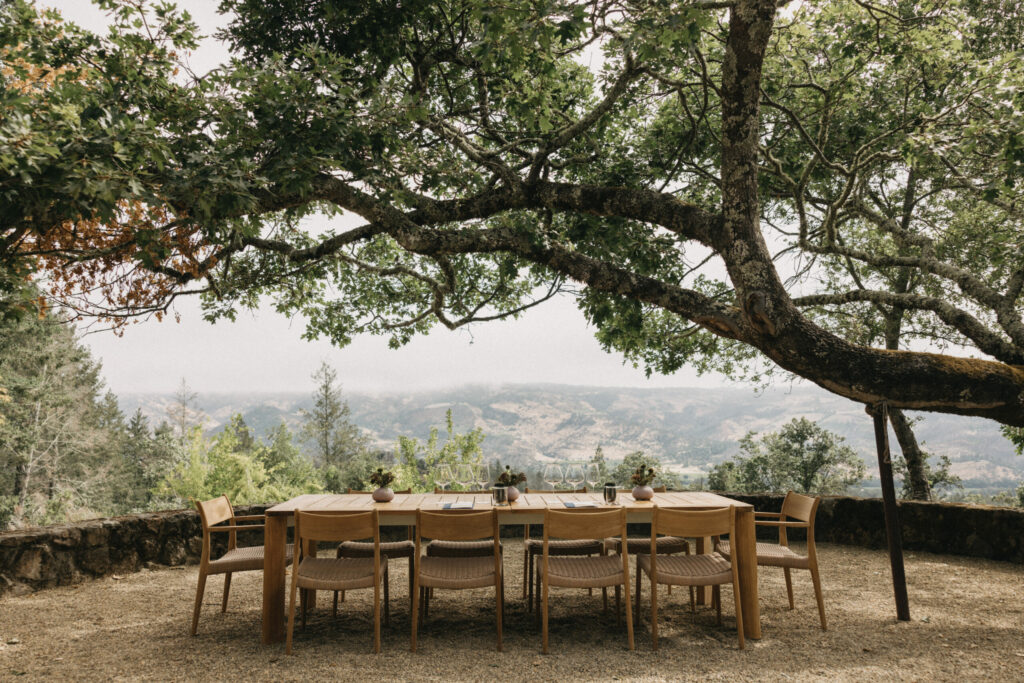
Beyond the bottle
Since you’re already surrounded by Bothe-Napa Valley State Park, why not take a scenic hike? Covering nearly 2,000 acres, the park includes 10 miles of trails amid a fragrant forest of redwood, oak and fir trees. Try the 3-mile Redwood Trail, a favorite for its shady canopy and mixed evergreen forest, then head to downtown Calistoga for a browse and a bite.
Stony Hill, 3331 St. Helena Highway North, St. Helena. Tastings by appointment only. stonyhillvineyard.com
Tina Caputo is a wine, food and travel writer whose work has appeared in numerous publications, including SevenFifty Daily, Visit California, HuffPost and Sonoma magazine. Follow Tina on Twitter @winebroad, view her website at tinacaputo.com, and email her story ideas at tina@caputocontent.com.
The post Revamped Napa Winery Combines Classic Wines and Midcentury Glamour appeared first on Sonoma Magazine.
]]>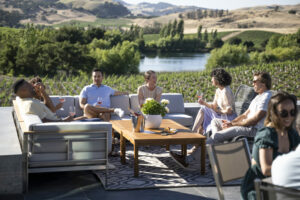
After more than 50 years in business, Cuvaison Winery keeps finding new ways to wow visitors.
The post A Couple of Tech Guys Opened Napa’s Cuvaison 55 Years Ago. It Keeps Getting Better appeared first on Sonoma Magazine.
]]>









Cuvaison has a long history in Los Carneros, predating the appellation itself. But that doesn’t mean the winery is stuck in the past. After more than 50 years in business, the Napa Valley winery keeps finding new ways to wow visitors.
The story
Stop me if you’ve heard this one before: A couple of Silicon Valley tech guys visit Napa Valley and decide to open a winery. That’s just what happened in 1969, when wine-smitten engineers Thomas Parkhill and Thomas Cottrell founded Cuvaison on a hillside property near Calistoga. The two Thomases sold the winery five years later to New York publisher Oakleigh Thorne, who then passed the baton to — are you ready for the twist? — a fourth-generation family of vintners based in Switzerland.
The Schmidheiny family recognized good vineyard land when they saw it. Soon after buying Cuvaison in 1979, they acquired 400 acres in Los Carneros as the focus for their new Chardonnay and Pinot Noir program. In 2009, the family built a modern winery and tasting room at the site.
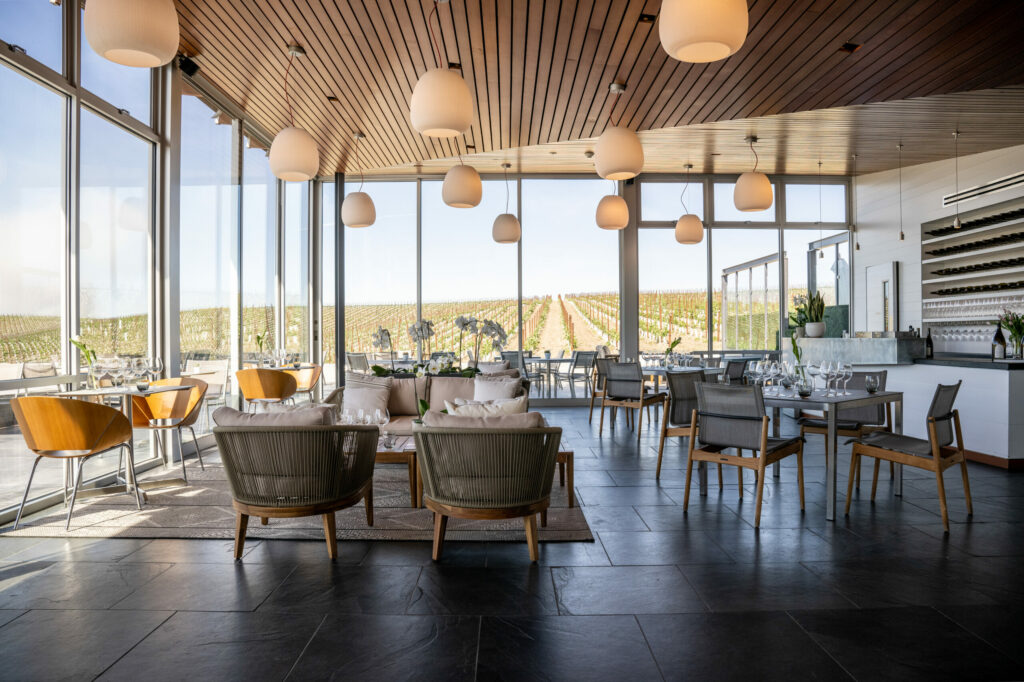
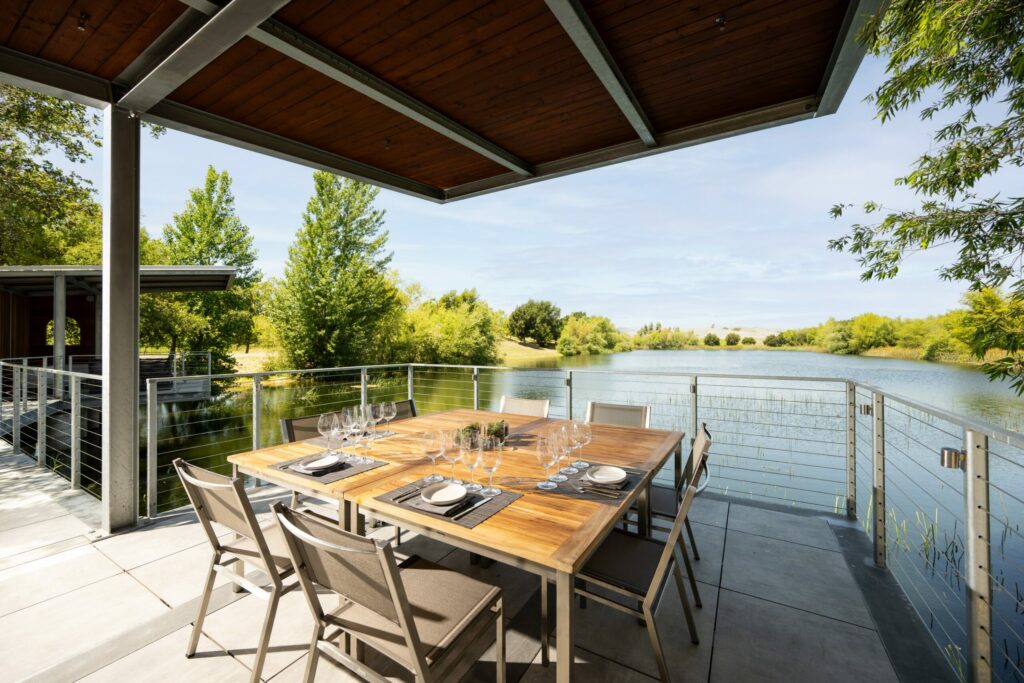
The vibe
Architect Douglas Thornley designed Cuvaison’s light-filled tasting room as an antidote to the dark, cellar-like atmosphere found at many wineries in the early 2000s. Outfitted with wall-size sliding glass doors that blur the lines between indoor and outdoor spaces, the contemporary venue presents panoramic views of the surrounding vineyards and hillsides. Cuvaison recently expanded its terrace tasting area and created two “boathouse” pavilions that extend out over a picturesque irrigation reservoir.
On the palate
Estate Pinot Noir and Chardonnay are the focus here, but it’s also fun to explore Bordeaux-style wines from Cuvaison’s Brandlin Estate on Mount Veeder. I’m sometimes wary of barrel-aged Sauvignon Blanc, but the wines can be truly gorgeous when the oak isn’t allowed to eclipse the fruit. The 2022 Brandlin Sauvignon Blanc ($50) is a prime example. Oak aging adds body to the wine, yet it retains fresh notes of lime, grapefruit and green apple.
If you’re over big, oaky Chardonnays, you’ll dig the 2022 Cuvaison Méthode Béton Chardonnay ($70). It’s made in an egg-shaped concrete fermenter that adds texture to the wine while bringing out its mineral notes. (Translation: yum!) Be sure to try the bright and silky 2022 Cuvaison 90.1 Pinot Noir ($80), made from a single clone planted on the Carneros estate. Standard tastings range from $60 for the Estate Tasting to $85 for the Winemaker’s Tasting, which includes artisan cheese pairings.
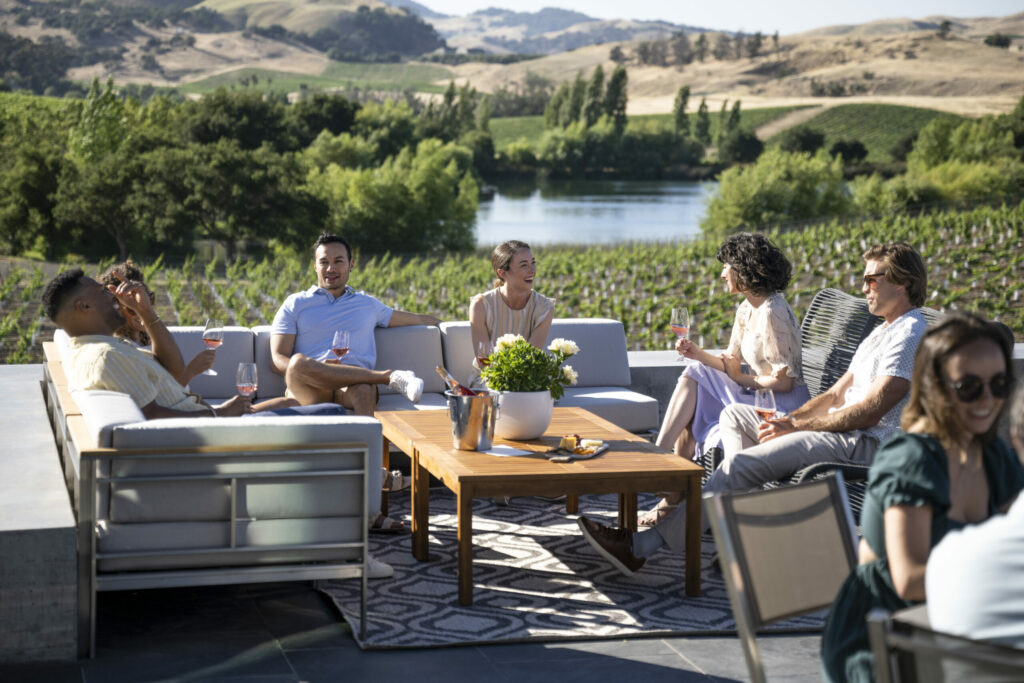
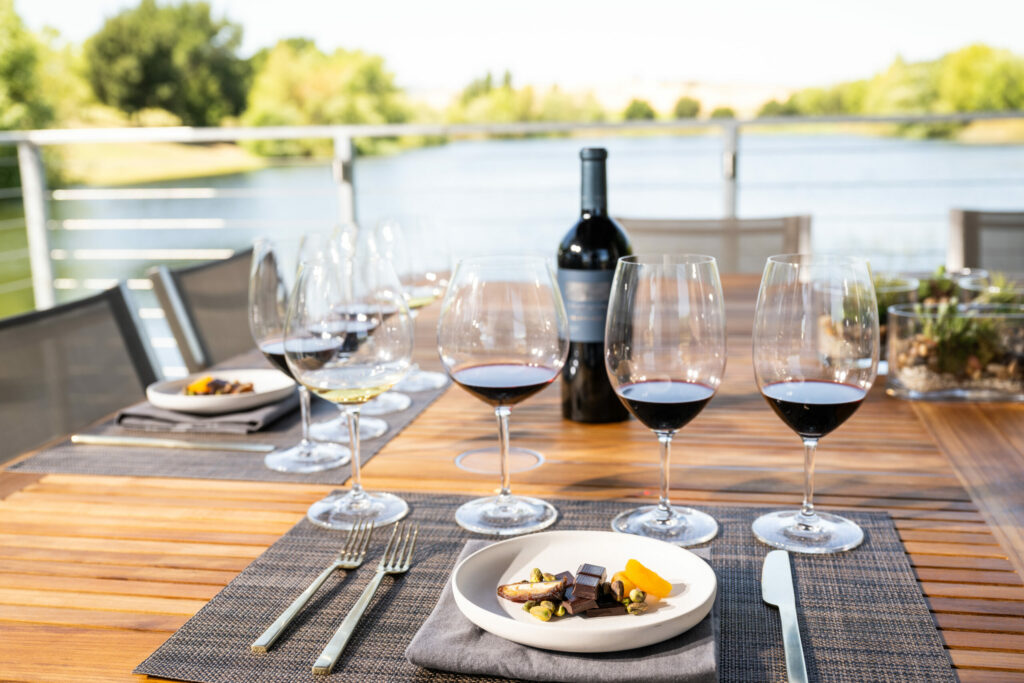
Beyond the bottles
As stunning as the tasting room views are, it’s hard to beat the serenity of the new Boathouse Tasting Experience ($150 per person). The private tasting for two to six guests includes a visit to the winemaking facility and barrel cellar, followed by a golf cart tour of the vineyards with views of San Pablo Bay.
Next, it’s on to the boathouses to sample small- and micro-lot wines expertly paired with gourmet bites like fried olives and duck tostadas. Cantilevered over a scenic irrigation pond teeming with ducks, cranes, herons and even the occasional freshwater otter, the open-sided redwood and steel structures let you imagine you’re relaxing on your own private dock with lively bird chatter as a soundtrack. Cuvaison has just two boathouses, so reservation times fill up quickly. This experience runs year round, weather permitting.
Cuvaison, 1221 Duhig Road, Napa. Open daily by appointment. cuvaison.com
Tina Caputo is a wine, food, and travel writer whose work has appeared in numerous publications, including SevenFifty Daily, Visit California, HuffPost, and Sonoma magazine. Follow Tina on Twitter @winebroad, view her website at tinacaputo.com, and email her story ideas at tina@caputocontent.com.
The post A Couple of Tech Guys Opened Napa’s Cuvaison 55 Years Ago. It Keeps Getting Better appeared first on Sonoma Magazine.
]]>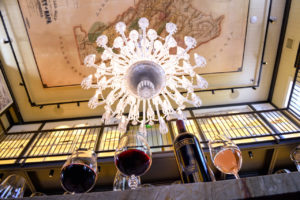
A wine museum/tasting salon, Boisset's latest project is quintessentially Boisset: a 48-light Baccarat crystal Zenith chandelier is the centerpiece.
The post A Peek Inside Jean-Charles Boisset’s Latest Wine Country Venture appeared first on Sonoma Magazine.
]]>









Wine Country roots run deep. There’s a fascinating story to be told about how this area became one of the premier wine growing regions in the world. But the hows and whys have a knack for getting lost when you’re happily sipping and swirling away — few are those who can remember the details the sommelier or tasting room server shared.
Prolific Napa Valley entrepreneur and vintner Jean-Charles Boisset is on a mission to make wine lovers a little more savvy. His latest business venture, 1881 Napa – the first wine history museum in Napa Valley – invites visitors to explore the history of the region through a self-guided tour.
“Napa Valley has a powerful place in American wine history and 1881 Napa puts the region in perspective on the world stage,” said Boisset in a press release.
As to be expected from a man known for his flamboyant style, Boisset’s new museum is equal parts informative, entertaining and extravagant. And there’s wine tasting, too. Click through the gallery for a peek inside.
1881 Napa, 7856 St. Helena Highway, Oakville, 1881napa.com. Open daily from 11 a.m. to 6 p.m. Reservations are recommended and can be made here.
The post A Peek Inside Jean-Charles Boisset’s Latest Wine Country Venture appeared first on Sonoma Magazine.
]]>